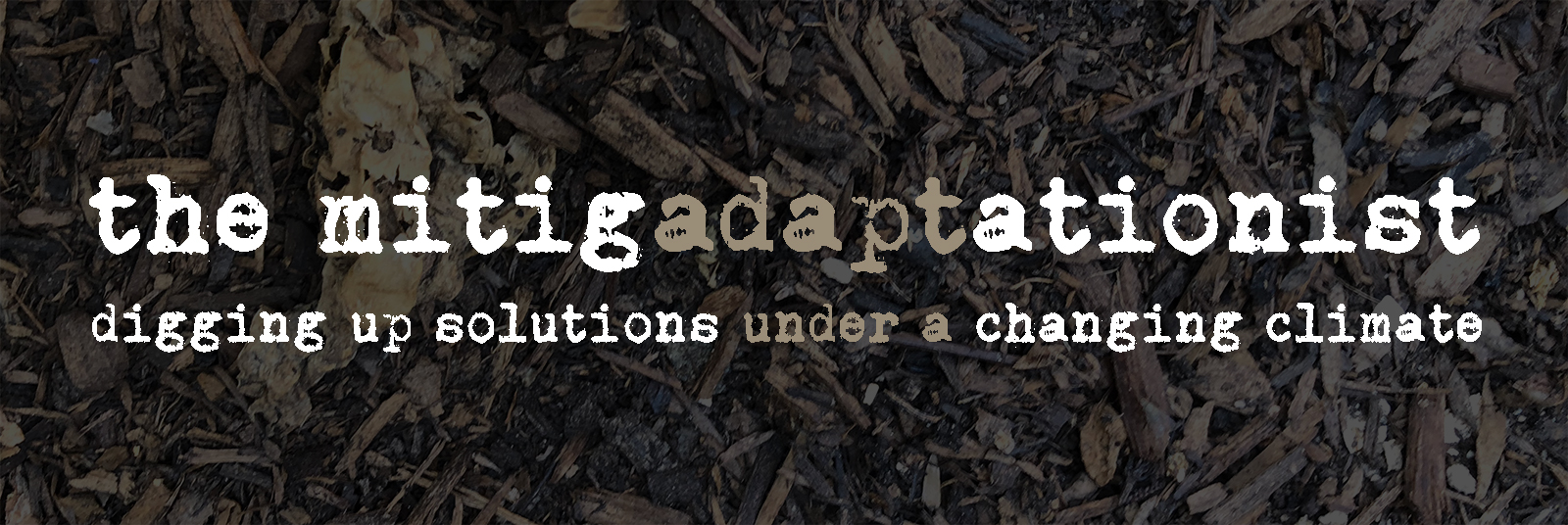
I Am in Love with Kelp
“I am in love with kelp.” Let Tiffany Stephens’ words resonate through your Saturday… and calm your climate anxiety. This video from Noema might show the way toward a new climate creativity around kelp, an abundant form of plant life you might not think much about when you’re not strolling a rocky beach.
Love affairs with kelp aren’t exclusive to cold northern climates. Down here in Santa Monica Bay — as far away from Seagrove Kelp Farm in Doyle Bay, in some ways, sadly, as you can be — there are also those who love kelp. I should know — I am one of them!
Locally, down here in the Santa Monica Bay, our Kelp Forest Restoration Project is a deceptively simple project that has for years been working to shift the subsurface balance of power from purple sea urchins — which humanity has been empowering since 19th-century trappers and furriers exterminated southern California’s sea otters — back to the kelp which is the very basis of the underwater ecosystem. It’s an extraordinarily labor-intensive process, but it’s a labor of love for the divers who often balance hectic urban lives with this rewarding application of their love of the water.
Having worked on a predecessor of that project a decade ago, I never look at Santa Monica’s quiet, sublime sunsets without also seeing-feeling the kelp forests beneath the surface. Once sensitized, you can see-feel the kelp forests swaying and breathing down there, involved as they are in an existential struggle for a system of life that mirrors that of the forests on land. They’re also an elegant, and fluid analog of their beauty.

Pictures of sunsets, but also of kelp, and of people not necessarily knowing they’re also seeing-feeling kelp.
As someone who’s also lived and worked in and loved Alaska, it’s easy to cringe at the proposed introduction of another extractive industry there. It’s easy for all of us with chronic existential extraction fatigue to reflexively despise any new industry encroaching anywhere, on anything, not least of all on the earth’s wildest and most untrampled lands.
But… kelp is amazing. And, referring back to the above video, it’s hard not to be seduced by the marginal impact of those boats gently farming cultivated kelp (which will be further reduced through this decade as electric boat engines proliferate).
“This is an optimistic space for me because I see it as a replacement, as a substitute, for things that are more destructive,” says Stephens, and she lists just a few ways kelp can help reduce the impact of human life on earth. These aren’t just, as we might imagine, boutique things like sushi or cosmetics, but also workaday products like plastic replacements or concrete polymers.
Could a kelp industry, scaled to meet its potential, have less of an impact than oil extraction, for instance, or other industries whose lobbyists work so hard to protect them from those who would balance human appetites against preservation of the water and land?
Zero-impact industries are the creativity we need to see.

We admittedly don’t know any active truck drivers, but it seems like some of them might willingly trade this sunset for one from a dive boat, after a satisfying day restoring kelp beds, and with a promise of an evening at a seaside bar. All things considered, we would too.
Finally, as robots take the wheel from the hundreds of thousands of truck drivers and cab drivers who are only the next in line to lose their jobs and ways of life, the next collective creativity we need to deploy is how to shift all the potential energy of surplus human labor to things like kelp bed restoration or kelp farming.
Market forces might bring the kelp to market, just as they brought trees to market. But since market forces demonstrably do not result in stronger forests of any kind, what forces can we use to connect labor to the larger existential, climate-surrounded goal, which is nothing less than forests that are as strong as they were before we started using them as our pantry, on the one hand, and began killing the otters on the other.
Those forces are the new creativity we need to see.
An easy first step to help take us there: get in love with kelp.
Get Creative!
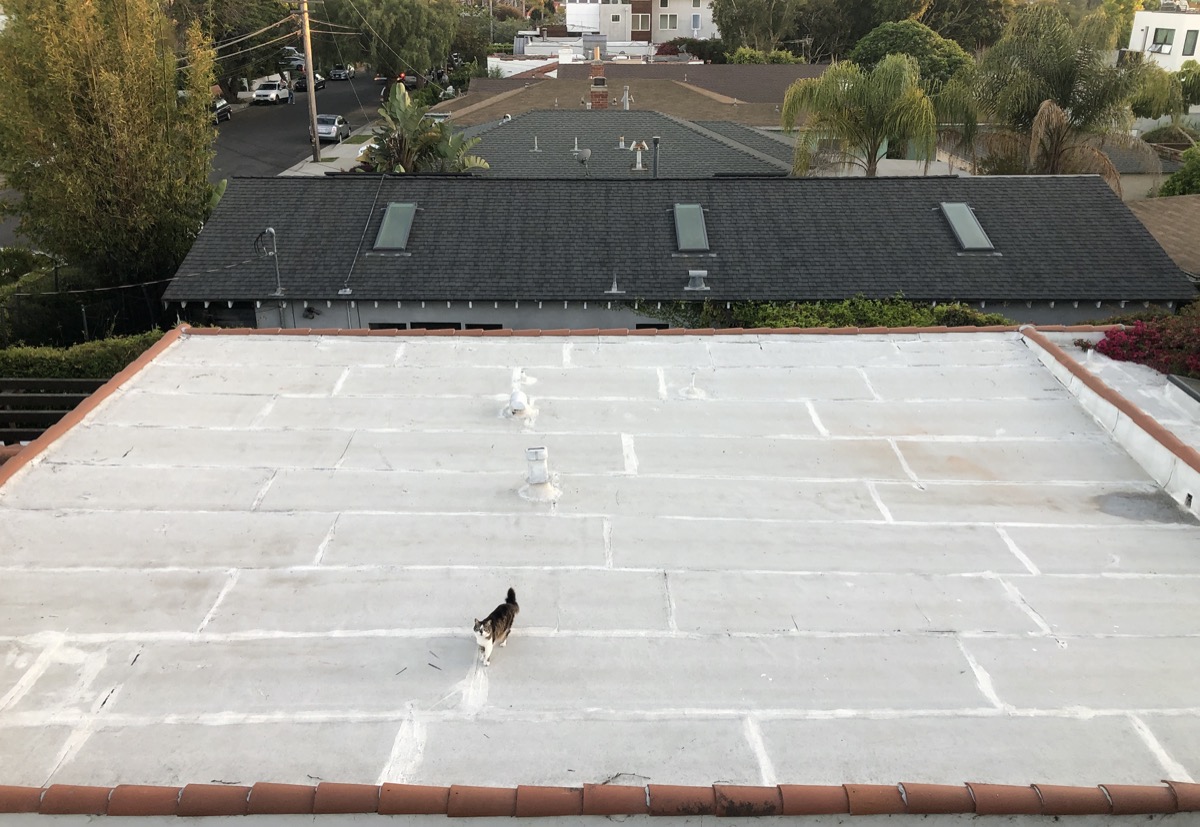
Watching the COP26 global climate talks from a rooftop 5,115 miles away, one thing is clear: it’s time to do the work. There’s no more time for doubters or denial on the one hand, or indecision or political traffic jams on the other.
At this point, the climate action stage should be filled with creativity. The seeds for this are planted. We’ve spoken to rooftop windmill makers, battery repurposers, solar-panel reconfigurers, no-BS climate communicators, serial forest nurturers, visionary climate adapters… and we know we’ve only scratched the surface.
Like all these neighboring rooftops, the climate challenge is a blank canvas. For most people we know, the question still remains, “but… what can I do?”
The answer is get creative. Whether it’s with an empty rooftop, or a pen, or a purchase, or a sewing machine, or a computer, or a vote, get creative.
Creativity is humanity’s superpower. And fellow superheroes, we have a world to save.
Rebuild or Relocate: Haulover, Nicaragua
The Gasoline Engine Is Officially Unethical
EVs are the stuff of myths. So many myths:
- They’re too expensive! (Nope.)
- Their batteries hemorrhage range as soon as you drive them off the lot! (Noooooope.)
- Worthless in cold weather! (Nope! And Norway!)
- They’re less green than normal cars! (NOPE.)
Let’s put that last old argument out to pasture once and for all.
Skeptics have long called EVs eco-wolves-in-sheep’s-clothing. Their claims, namely that (a) batteries are made from un-green materials that must be extracted from the earth; and (b) EVs are fueled by the un-green grid, are rooted in truth, but don’t stand up to the big picture.
In the olden days, you could painstakingly win the argument by pointing out the electric engine’s vastly superior efficiency, and the constant greening of the grid in all U.S. states, and the perpetual improvements in batteries and their disposal and re-use. But the argument took time; you couldn’t quite bust the myth with a single, easy, argument-killing graphic.
BEHOLD, today, that elusive singe easy argument-killing graphic! Compliments of the Union of Concerned Scientists.

In said graphic, models of cars are represented by dots, with the black dots being conventional cars and the yellow dots EVs, plotted as emissions per cost. (The red dots are hybrid-eletrics, which are a transitional technology that’s being replaced as quickly as it’s been emerging.)
The Union of Concerned Scientists’ data have been shifting over time as all kinds of cars have improved, with EVs pulling away toward victory. This graphic illustrates the green-nesses of EVs and ICEs not only not intersecting, but not even coming close to intersecting. Not a single available internal-combustion model — no matter how expensive it is — is as healthy for the climate as any available pure electric model now being produced.
So, did the concerned scientists cherry-pick their data? Do they leave out the carbon cost of building the car and its batteries or disposing the car and its batteries? Nope — the “well-to-wheel” data take into account each vehicle’s full lifetime footprint from creation to operation to disposal.
Clear as the data are, they won’t end the myths. As William Totds wrote last year in the Guardian:
There will always be a new study with some flawed assumptions to keep us all busy and we could rebut these until we all drop. The advantage for the oil and diesel industry is that articles and reports, however poor, keep the controversy alive. Discrediting or distorting science is a political strategy, as Naomi Oreskes chronicles so well in Merchants of Doubt.
True enough. But in the real world the argument is over.
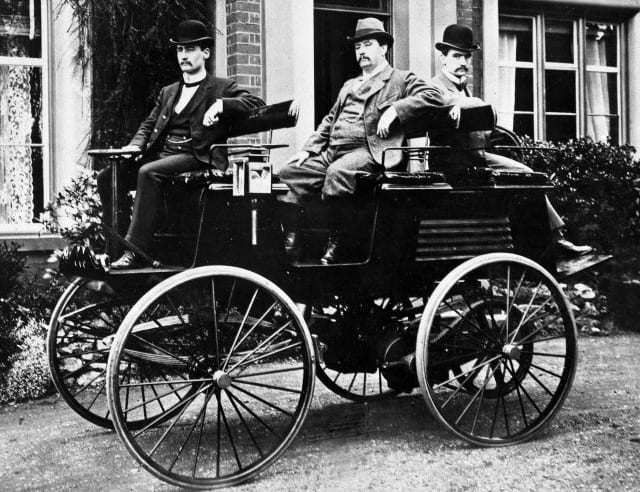
The intrepid English inventor Thomas Parker shows off his 1883 electric vehicle, fully 25 years before the first Model A rolled off Ford’s factory line and settled the electric vs. fossils question… for the time being.
Buy a Car Like It’s 2036
Consumer Reports reports that today’s cars will last an average of eleven years — and, with love, fifteen. So the ethical calculus has to factor the commitment of the earth to fueling the car you buy not just now, but also until 2036 or even later.
That’s right, your new Camry or Camaro still could be pulling up to the gas pump four presidential terms from now — by which time we may have shifted the grid entirely to renewables. With solar and wind continuing to wildly outpace fossil fuel development, by then we may not be drilling for oil for any purpose other than specialty plastics… and to keep obsolete cars alive.
The electric-vs-fossils decision is nothing new. Electric cars were being developed right alongside internal combustion vehicles across the early history of horseless carriagery. In the end, it wasn’t ethics that made the fuel decision for us, but the discovery of plentiful oil.
But today, the decision is very ethical and it’s a clear one.
Buying an electric car is the demonstrably “greener” personal decision. But larger than that, it sends a message to the auto industry that consumers are moving forward. It sends a message to government at all levels that it is time to invest in infrastructure around EVs, and start dismantling the massive, subsidized global machine we’ve built around petroleum.
And finally, perhaps, buying an EV is a “gateway” decision, which gets each of us individually thinking about how we can continue to green up our lives. If we have an EV, can we go a step further and build it a solar carport? Can we go a step further from there, and streamline things so the solar carport serves all our power needs?
Don’t get us wrong. Buying new stuff won’t save the world. But good decisions, in a larger sense, will. Something as impactful as the engine in your car needs to be a good decision.
Glocal Warming, Glocal Response
It can be hard to conceive of an issue as big as climate change. Global warming is, after all, global — geographically but also as an idea. Reflecting its sprawling unknowability, some environmentalists like to say “think globally, act globally.” Others use the invented term “glocal” to describe a phenomenon that’s both planetary in scale and also felt and fought locally.
Still others — especially those themselves impacted — address the problem as purely locally as they do the rest of their lives.
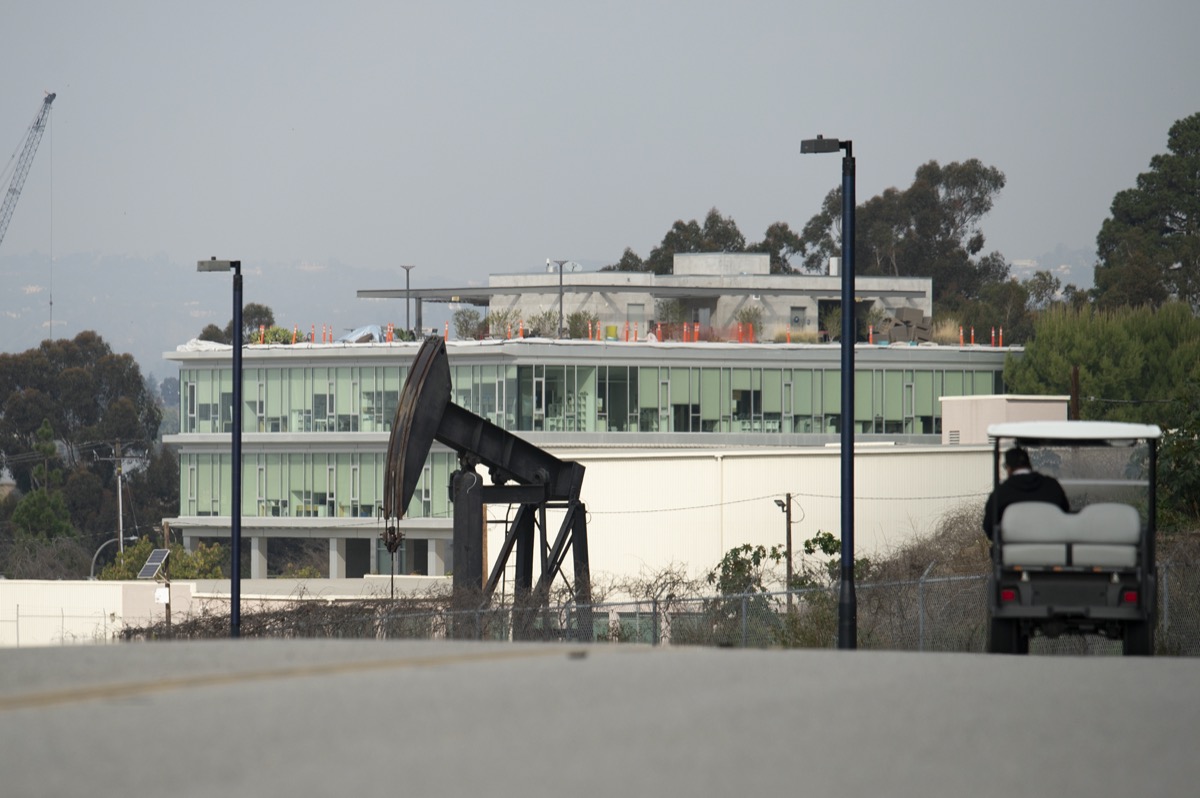
Global and local issues can be hard to tell apart. Here in Los Angeles, for instance, some apartments come complete with an oil derrick in the backyard — a striking image, though not one as well-known as the Griffith Observatory gleaming above the city’s palm-lined boulevards. Those relentless derricks are “glocal”: if we can rid the world of its giant pipelines and massive oceanic wells, we’ll rid our neighbors of this too.
Los Angeles, with its population of 3.99 million, is “the largest urban oil field in the country” and the cultivation of both crude oil and natural gas within city limits makes toxic airborne gases a persistent part of the local climate. Of course, this mixes with transport exhaust that’s still so thick that the 710 freeway corridor connecting downtown Los Angeles and Long Beach is known unsentimentally as a “diesel death zone.”
You’re likely to hear us old-timers say that “the smog’s not as bad as it used to be.” Yet toxic air is as persistent a problem as ever, and as fluid as air is, the impact is not felt equally by all 3.99 million of us.
The climate is indeed unjust. The direct relationship between being black or brown and the likelihood of living in areas with toxic air or water is well documented, and so the direct connection between being black or brown and higher incidence of Covid-19 is not surprising.
As bad as a “diesel death zone” sounds, living in a “sacrifice zone” sounds even worse. It rings an especially resonant note of injustice in the voice of Jasmin Vargas in KCET’s hourlong documentary Power and Health, as she tells her part of the story of how power influences the collocation of people’s homes and workplaces and deadly environmental toxins.
Her fight is indeed a local one, but it is a mirror of those we all need to wage together. Whether our focus is on energy or trees or plastics or geopolitics, the work needs to be simultaneously happening at all levels, from the most personal to the most political, from the most local to the most global.
Those who aren’t fighting a battle for their own family or community can follow whatever mantra is most inspiring: think global act local; think local act global; think local act local; think global act global. Our purpose can be found wherever it comes naturally, but the secret lies in a different, nonsense-free mantra: in just do(ing) it.


The affluent aren’t immune from local impact of a global problem: burned trees and a houseless chimney at Tigertail Road after the 2019 Getty Fire, January 2020. Mount Saint Mary University’s Chalon Campus in the middle ground was spared from the blaze, but its students won’t soon forget their “harrowing” escape.
(Up top: Oil derricks and a new apartment building in south Los Angeles, April 2020. The resemblance to grazing dinosaurs is perversely poetic.)
“Net Zero by 2030”
This feels like momentum, folks.
The Guardian: “Three-quarters of Australians back target of net zero by 2030, Guardian Essential poll shows.”
Must each of us witness destruction like Australia has seen before we reach this conclusion… or have we all seen enough?
Net zero by 2030*. If we want to survive in a world that’s something like the one we live in now, we must all be like three out of every four Australians, and demand nothing less than that.
And then work our dingoes off for it.
*For more info about the actions we’ll need to take to reach net-zero by 2050, please see the IEA’s new “World Energy Outlook 2020.” It’s strong medicine…
This Holiday Season, Let’s Give Shopping a Gift of Its Own: A New Purpose

All the days following Thanksgiving celebrate our prodigious gift for shopping. “Black Friday,” whose name dates back to 1966, is followed by the newly minted “Small-Business Saturday” and then a quiet pious day to get rested and prepared for “Cyber Monday.” That’s the day you’re supposed to continue fueling the economy while on the clock at your job ostensibly doing something else. “Giving Tuesday” stands at the end of the line, ringing its bell and giving you the guilty side eye after all this consumerist bacchanalia.
It’s easy enough to sigh in anguish, á la Charlie Brown, about the rampant consumerism, but a little empathy may be in order too. After all, for a stressed-out, disconnected, compromised human organism, shopping is a dopamine-triggering easy pleasure. Through the 20th century, it became the way comfortable modern people in comfortable modern societies expressed their comfortable modernity. By now, shopping is such a native skill that we interpret much of how we experience our world as acts of “consuming” and “collecting.”


Left: 1918, watching Santa climb from his parade float into Eaton’s Department Store, Eaton’s Santa Claus Parade on James Street, Toronto. Right: 2008, iconic image from just prior to a shopping stampede at a Long Island Walmart, which killed one shopper and injured four others, according to the Black Friday Death Count. (Eaton’s / Augustine for News)
The 21st century added to the recipe: plentiful plastics, round-the-clock R&D, disposable LEDs, 24/7 marketing, microchips as cheap as potato chips, and a competitive international labor market. So today, we consume all products as consumables. We consume everything as if it’s disposable. We’re a big machine for converting raw materials into landfill.
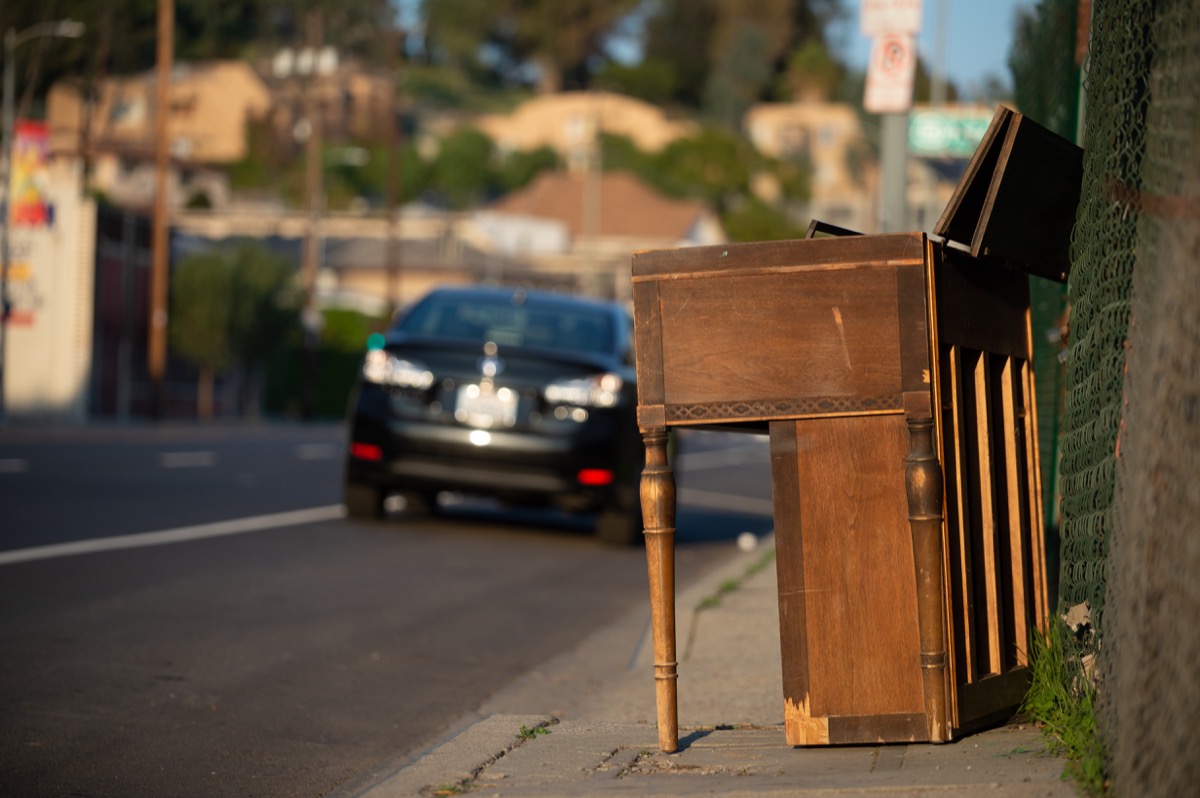

Broadway, downtown Los Angeles: it’s often cheaper to buy a new piano than to repair an old one… so we mine some new metals and harvest some trees to keep the music playing in the drawing room. But what’s to become of the family heirloom?
That said, if the 20th century turned human beings into consumers, it’s not the worst new skill we learned. And maybe we don’t need to be so Charliebrowniest about something that is, after all, a skill… and a big chunk of the economy. Maybe it all just needs a new purpose.
Shop ’til We Drop — for the Climate?
We climate evangelists are supposed to preach against consumerism, but the message isn’t that simple — since many climate solutions seem to demand that we make and buy new things.
In fact, climate mitigation is shaping up to be an orgy of consumerism. To turn the page on internal combustion, everyone’ll be buying new electric or hydrogen cars, motorcycles, trucks, scooters, and whatever people-movers come ’round the corner next. To transition from natural gas, we’ll scrap our gas heaters, water heaters, and stoves, and head out to buy new electric models. To clean the grid, we’ll cover all our roofs with solar panels and mount giant batteries on the wall to compensate for unsteady photovoltaics and wind turbines.
Those photovoltaics and wind turbines will need unprecedented volumes of new metals and minerals. Plus, depending on whom you ask, we can’t forget to swing by the uranium shop to fuel the new fleet of little modular next-generation nuclear plants that will help break the natural-gas addiction we’re now acquiring.
In other words, it’s time to shop ’til we drop… for the climate! But it means rethinking the rest of our shopping, and the 69 percent of the U.S. gross domestic product that it represents.

Do We Even Like Our Toys?
According to research (of which here is some), we’ve been giving babies and toddlers toys they like less and less with every passing decade. If given a choice, babies and toddlers will reach for simpler toys with logical feedback over complicated plastic items that do unpredictable things like bleep and flash. Generally, young children prefer things like blocks, bowls, and natural materials to the latest plastic branded product. Babies get seemingly endless satisfaction from testing Newton’s laws of motion with easily conceived, tactile objects. And, if given blocks they can stack, they can do things like collaborate at much younger ages than expected. In other words, kids like simple, natural toys better, and those toys are better for them.
As for the rest of us, it’s fair to ask ourselves whether we like our toys as much as we think we do. For one thing, if we like our things so much, then why do we constantly replace them? To paraphrase the Grinch, maybe satisfaction “doesn’t come from a store.” How many bottle openers do we need? How many place mats? Bungee cords? T-shirts commemorating our every achievement? Outdoor speakers shaped like rocks? Stuffed animals? Does everyone in the neighborhood need a ladder that we use once or twice a year? How frequent must be our new televisions, computer monitors, tablets, bluetooth speakers, and all the wires that tie them all together?
What do we really want to play with? How about the time we would gain from not working to buy more things? How about experiences? We’ll leave these bigger questions for another time.

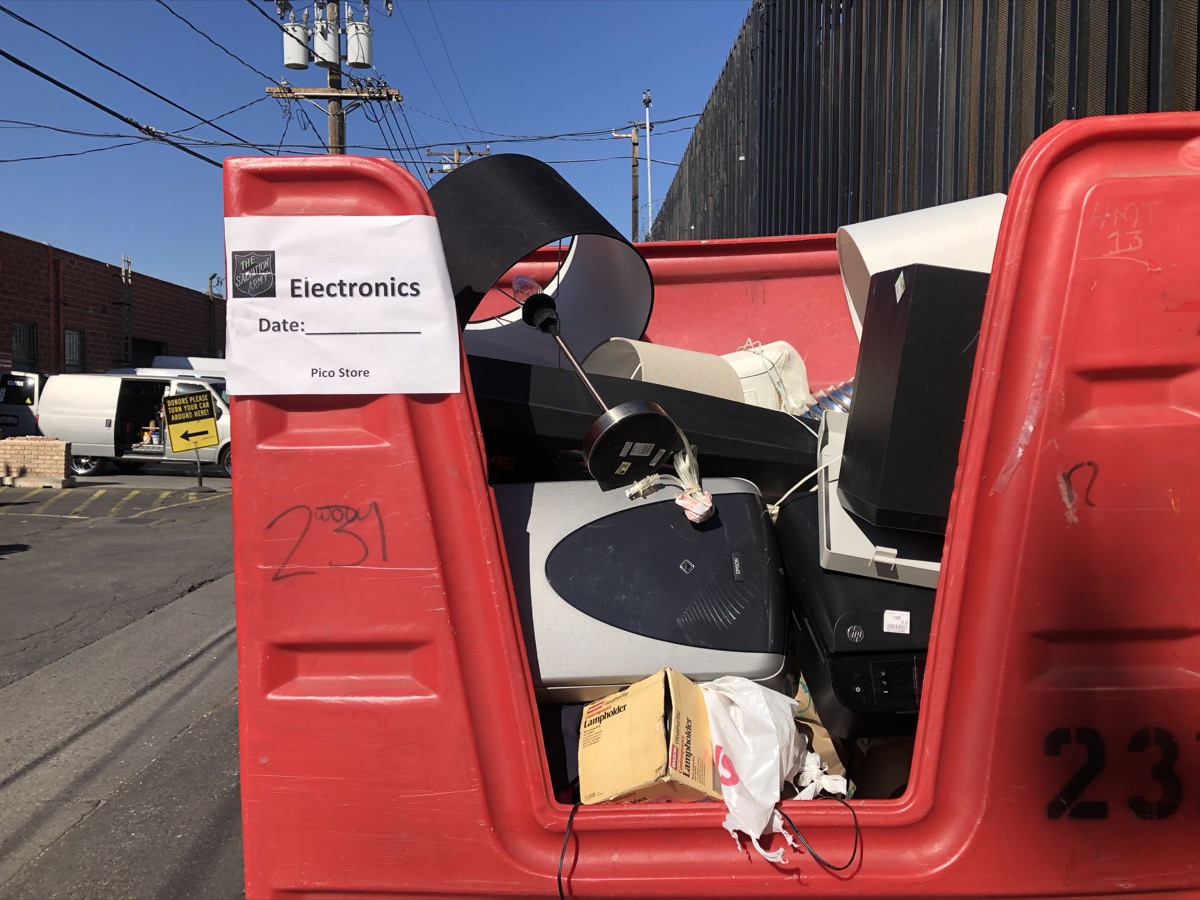
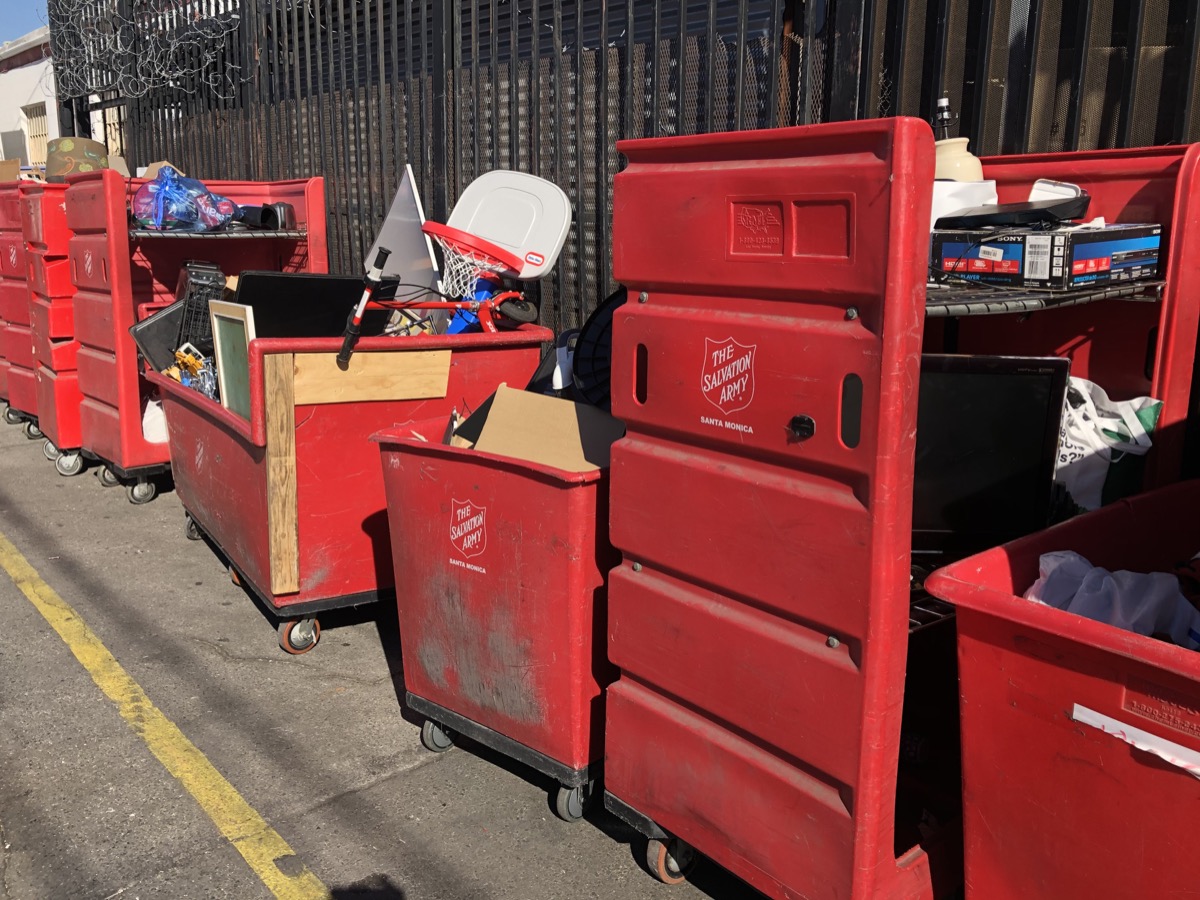


Santa Monica Salvation Army: STUFF. Formerly raw materials peacefully stored in the earth’s crust; then, dopamine-inducing purchases; then, awkwardly waiting to be sorted on the way toward the landfill. As for the bale of clothes at the bottom — the average American throws away 81 pounds of clothes a year. Empathy stops here. This has to stop.
Sacrifice?
Moving into the coming phase of climate action, climate communicators tiptoe around the word “sacrifice.” Is this a “war footing” we’re going to be on, where we need to ration butter and turn in our extra ladders to be melted down into offshore windmills? Or, is it a man-on-the-moon effort requiring of the public a lot of cheerleading and modest behavioral changes?
If we all agree we need to reach “net zero” by 2050 (we do), and have to get perhaps halfway there by 2030 (we do, because the other half will be more difficult and require twice more time), how do we approach the easy sacrifices (“I no longer need a commemorative t-shirt every time I attempt a half-marathon”) and do we approach the harder ones (“I can no longer eat food that pleases me”)?
A Clue from Covid-19
In this month’s Foreign Policy (subscribing online-only now for the climate!) Max Ehrenfreund reported a clue in the economics of American survival during Covid-19 — “The World’s First Affluence Recession: The pandemic is making Americans poor—precisely because of the way they were rich”:
The modern economy has been immune to infectious disease—until now. Epidemics in the modern world have ruined hopes, debilitated bodies, and claimed tens of millions of lives. This [is] the first epidemic in American history that has also caused an economic crisis. Between April and June, about $2 trillion of economic activity in the United States came to a halt. Adjusting for changes in prices, that was nearly one tenth of gross domestic product. Even though public-health authorities and ordinary people took similar steps to stop past epidemics from spreading, none had remotely comparable effects on the economy—not cholera, which struck repeatedly in the 19th century; not the fearsome bubonic plague, which visited San Francisco in 1900; not even the so-called “Spanish” influenza that arrived in the United States in 1918 and killed tens of millions internationally.
What has made this pandemic unique is that for the first time, consumers worldwide can afford to spend a significant share of their incomes on non-essential goods and services. Much of their consumption has become optional, and rather than risking death to buy a Frappuccino, they’ve chosen to stay home. Others would like to go out, but public-health authorities have ordered non-essential businesses to close. Because the discretionary share of consumption has expanded, the choices about non-essential business that governments and individual consumers make in response to pandemic disease have become an economic problem.
The shift in the makeup of economic activity is due to decades of transformative economic growth. Previous epidemics did not cause economic crises because most consumers were poor by today’s standards, and their discretionary spending was minimal. The overwhelming demand for necessities such as food and clothing, which neither households nor governments could restrict in the interest of public health, kept the economy going. Today’s economy depends on a thousand luxuries large and small, from overpriced coffee to air travel, and these luxuries are what many consumers are now giving up. Willingly or not, they are saving instead of spending. Extreme savings rates are a defining feature of the available data on the coronavirus economy.
The public-health crisis is the result of a novel pathogenic coronavirus. But the economic crisis is a result of our affluence. Growth has created both extraordinary prosperity, and previously unknown risks.
(Quoting excessively because there’s considerable guidance here.)
So, how much disposable income is disposable in trade for our future?
How shall privileged humans spend money and time for the rest of this decade? How shall they act for the next three decades while we bring ourselves back into harmony with the earth that sustains us? How shall we choose to design a future that features the luxury of assuming that great-grandchildren will still be able to live with the comforts enjoyed by their great-grandparents?
We can shop thoughtfully, deliberately, and with purpose for the future we want. And, we must.
How to Organize, Organize, Organize: Step 1 – Fall in Love
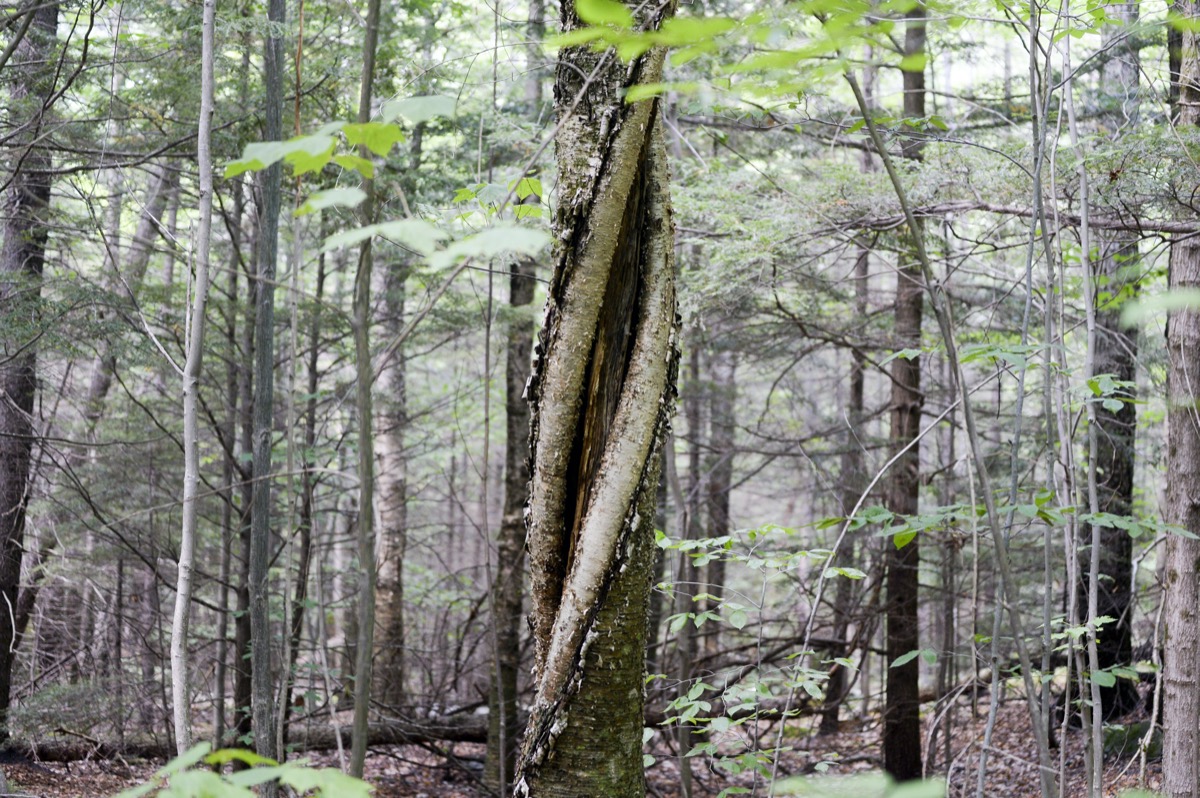
The more we learn about trees, the more we understand that they communicate and share resources through their roots, recognizing one another’s needs and working toward shared goals. This might be a relevant metaphor.
It’s November 2020, and we know that humanity has just this one decade to stave off the worst impacts of climate change. We can achieve this, but the sheer scale of the problem means it’s all hands on deck.
I think people want to do something about it, but most don’t know where to begin — beyond reducing our own consumption and our “carbon footprint” (here’s 35 ways, for instance, to do that). Some people already personally impacted don’t have the luxury of not knowing where to begin. Others are already integrated into an activist community, or are veteran environmentalists, or have an blue-ocean idea that inspires them. Some have have a relevant Ph.D., some have an audience of millions they can influence. But what about the rest of us who know we want to roll up our sleeves but not how?
These days on Zoom, one answer you hear a lot is “organize, organize, organize.” But for the non-organized among us, what does THAT mean? It means simply to hook up with an existing organization, cause, or group that really speaks to us.
Unless you have massive resources to spread around, it’s a good idea to choose just one org that makes you swoon. Treat it like dating — do your research and be discerning, because there are a lot of fish in this sea. A lot of good fish, too. If you choose one and find it doesn’t inspire you, drop it. Find another, or in the end… you won’t end up engaged.
Aim for butterflies. It should be more than just writing an occasional check. Your match should excite you, should inspire you — to volunteer; to join or lead a committee; to help raise money; to collect water samples or monitor king tides; to take photographs, write poems, or use your social network to spread the word… to give whatever you have to give. You’ll meet like-minded people, and you’ll move forward into this decade together.
You already have a busy life — to be motivated to give more and do more, you need to be inspired by the cause you choose. One thing those of us who run nonprofits inevitably learn is that no matter how magnificent an answer we have to one of life’s persistent problems, it won’t appeal to everyone. Whether it’s emergency response, or feeding orphans, or curing terrible diseases, or rescuing puppies and kittens, some people will always be more interested in something else. Likewise in the climate space, some people will be more interested in windmills or solar for remote villages … or planting trees … or clean air and water … or protecting undeveloped spaces … or reducing consumption of plastics … or electric cars … or sequestering carbon … or replacing wood fires with cleaner fuel … or being or amplifying youth voices fighting for climate mitigation, climate resilience, and climate justice … or reclaiming copper for use in windmills … or… or… There’s something for everyone!
Global warming, as the name implies, is a global problem, and different solutions and amazing ideas are cropping up everywhere in the world. Pour yourself a cup of something, and ask your friends or neighbors if there are local efforts to join. Or, try jumping into any of these “dating” sites to get started:
- The Climate Coalition
- Medium/Thales Dantas: “Organizations Fighting Climate Change: A Quick Guide”
- Vox: “Want to fight climate change effectively? Here’s where to donate your money”
- NAACP: Climate Justice and Environmental Organizations
- Vice: “12 Environmental Justice Organizations to Donate Time and Money To”
- The U.S. Climate Action Network
- UNICEF: Youth Action
- List of Accredited Organizations by U.N. Environment
- State of California: “List of Worldwide Scientific Organizations that hold the position that Climate Change has been caused by human action”
- Outdoor magazine (2016): “The 6 Best Environmental Groups to Donate to for a Better World”
Get carried away by the search, keep trying, don’t be afraid to fail and start over, and finally, let yourself get carried away. Because if you don’t, you might someday wonder how you let the years go by without it.
And then one day, this decade and its promise will be gone.
Even “If Washington Is Lost”: We Now Know How to End-Run Federal Obstructionism, Anyhow

Sunrise, Penn Cove, Washington: every new day is another lesson in resilience.
For the climate, last night’s unresolved elections in the United States couldn’t have higher stakes: this January, one of the world’s biggest energy and environmental policy stakeholders will either be demonstrably hostile to science and climate action, or committed to spending $trillion$ to guide climate adaption and mitigation.
But even amid the election chaos, I’m reassured to know also that during the last four years, climate creatives in the form of smaller nations, U.S. states, organizations, and individuals have innovated in yet another way: learning how to do end-runs around an obstructionist U.S. government.
Great read in Politico
Until we know the election results, you can get some comfort from Monday’s article in Politico, which was profoundly reassuring despite its apocalyptic title: “The Environmental Movement Braces for a Second Trump Term.”
As Karl Mathesien writes, after having failed to prepare for the Trump administration, we are now much better prepared to meet U.S. obstruction as we face one final decade in which we can make a significant climate difference:
In the U.S., environmentally conscious youth are preparing for war. But also admitting that fighting the administration on climate directly won’t be their goal. American climate activists are battle-hardened, allying with wider social justice and anti-racism campaigns and taking nothing for granted, said Henn. “We’re hosting mass trainings on how to prevent a coup, planning efforts to go after Wall Street if Washington is lost.” Other groups expect court battles to feature heavily, despite a broad conservative shift in the judiciary under Trump.
Luisa Neubauer, a German activist with the Fridays For Future movement, said European leaders would also feel more pressure if Trump wins. “Wherever the U.S. fails to reduce emissions or finance climate mitigation, other states have to make up for that — that’s how a collective crisis works. It’s more work for everyone.”
Groups that lobby through international diplomacy, like the ECF, will focus on isolating a Trump-led Washington by encouraging other countries to simply move on.
Please read the article, and our own post here, for more climate action energy and a lot of links to more.
And remember, every setback is yet another lesson in resilience: because if we’re going to succeed, our first duty every damned day is to wake up focused and positive and a little bit more aware of how to defeat those who stand in our way… or to just ignore them and move on.
More Cause for Optimism: “We’ve Had So Many Wins”

Without permission but with gratitude. Click to read about the Guardian‘s climate pledge, which is good journalistic leadership for a world with a hard deadline.
Last month we wrote about the importance of optimism as the global community prepares to tackle climate change in one decade.
In that spirit we present this Monday’s article in the Guardian: “‘We’ve had so many wins’: why the green movement can overcome climate crisis.”
It’s a quick reminder of many of the often unheralded successful precedents of the environmental movement. These include the global end of “leaded” fuel, the international rescue of the ozone layer, the end of acid rain almost everywhere.
The older among us will remember that these problems seemed hopeless at the time. But, writes Fiona Harvey, the global community solved them anyway:
It is easy to forget that environmentalism is arguably the most successful citizens’ mass movement there has been. Working sometimes globally, at other times staying intensely local, activists have transformed the modern world in ways we now take for granted. The ozone hole has shrunk. Whales, if not saved, at least enjoy a moratorium on hunting. Acid rain is no longer the scourge of forests and lakes. Rivers thick with pollution in the 1960s teem with fish. Who remembers that less than 30 years ago, nuclear tests were still taking place in the Pacific? Greenpeace’s Rainbow Warrior ship was blown up by the French government in 1985, with one death and many injuries, in a long-running protest.
As well as giving heart to activists now, these victories contain important lessons. “The environmental movement has been very successful,” says Joanna Watson, who has worked at Friends of the Earth for three decades. “We’ve had so many campaigns and wins. Sometimes it’s been hard to claim success, and sometimes it takes a long time. And sometimes things that worked before won’t work now. But there’s a lot we can learn.”
We should all nail this article to the wall where we can see it. What can inspire genuine optimism better than a perpetual reminder that, when we’ve had to, we’ve succeeded before?



Humanity put its mind together and concluded that we simply did not need chlorofluorocarbons to evenly distribute liquids — and so we didn’t have to sacrifice the ozone layer for convenience. In fact we didn’t have to sacrifice anything at all. Here, in our informal analysis of aerosols, a dime store squirt bottle delivers a nice, even distribution of water at a light source one meter away. (Squirt bottles remain a better solution than pressurized cans even without the CFC factor — see this 21-year-old artifact for still-current info.)
What Connects Us All If Not Our Climate?

As we noted a few years back, this is the century in which humanity will re-deepen its relationship with its surroundings. The reality is, we’ll either have to do this consciously and deliberately, in the process of extricating ourselves from our climate peril, or we will reconnect inadvertently and reactively as we learn to live on a diminished planet with an unfamiliar and hostile climate.
Certainly for some, the pandemic provided an instructive opportunity to slow down, pay attention to the natural world, and get connected. Today, as we write these words, the California pepper trees in our front yard are providing just that kind of opportunity. Though it’s not spring, they are in blossom now and a welcome source of non-political conversation on our street.
Did you know that every single peppercorn that ends up in your pepper grinder starts as a blossom? Every year those minuscule yellow flowers explode in clusters and turn the trees into resonant bee clouds that buzz for weeks. Young parents on the sidewalk wander right into it, then flee across the street behind their strollers. But they’re in no peril — these bees are obsessed with their work and seldom rest long enough even to pose for a clear photograph.

Our old posts on California almonds and white clover got us thinking about the precarious condition of the honeybees — the farmed ones and the wild ones, respectively — and how tied that species is to us humans. Farmed and wild bee populations may or may not be the equivalents of our salaried workers and independent contractors, but either way their labor is just about as big business as that of their human counterparts. Honeybees and other pollinators are responsible for perpetuating 70 percent of the world’s food crops. Alone, the aforementioned almond farms of California’s Central Valley require the labor of half of the honeybees in the United States.
To say the least, wherever go the honeybees, we go too. And so it is with the oceans, the soil, the rivers, the atmosphere right up to the Karman Line, the entire food chain from the tiniest insect to the largest lion… and one another.
(An observation hopelessly kumbaya not long ago. Today: life and death!)
While human connection may seem like an especially hopeless aspiration at a time like this, on the other hand, what connects us more than the climate? What connects us more than the air we breathe? Our giant air bubble connects every demographic with every other demographic. For instance, in China’s smoggiest years, citizens consoled themselves, mostly accurately, that their leaders, for all their luxuries, had to breathe the same air they did. And indeed, China invested trillions to claim global leadership in energy technology to move us all beyond dinosaur fuel, and indeed the lungs of all China’s economic strata are reaping the rewards. For that matter, so are ours outside China as the cost of solar plummets and more of us are able to make smart climate decisions as a result.
No one is immune to bad air locally, and no single country is immune globally. Neither is any nation wealthy enough to solve the crisis by itself. What do all 7.8 billion of us humans share, if we don’t share the climate systems that roll over countries and cross borders with the ease of post-internal-combustion engines blowing by mileposts? What can bring us together in all our diversity, if not a shared investment in a healthy climate with its byproducts of healthy oceans, recognizable seasons, and familiar latitudes and longitudes?
Bees Aren’t Distracted by Human Abstractions
If we’re going to get this done — and the 2020s are the last decade in which we can — we need to move past both nationalism and globalism, isms that divide and separate. We need to ditch those isms in favor of building new intra-human neural pathways for the kind of collaboration that will be necessary for us to confront the challenges ahead of us: challenges that care as little about borders or other human abstractions as do these honeybees who remain so fixated on their work… with utter disregard for whether they’re in Canada or the United States, or in Luxembourg or Belgium, or in North or South Korea, or in Kashmir or any part of Cyprus.
These here bees are as un-national as any migrating bird. They don’t care. They just get it done. Like we now have to.
The era of globalism brought the honeybees habitat devastation, indiscriminate global pest control, wild climate fluctuations, varroa mites and other bugs of all sizes, and whatever other factors cause colony collapse disorder, and the bees carried on with their work anyway. By contrast, we looked at factors like the widening gap between rich and poor and allowed the toxicity of nationalism to seep back into the human condition.
The rise of nationalism on a scale of all humanity wasn’t a bump in globalism’s road. Globalism is an irredeemable wreck alongside the aforementioned highway of history. Yes, the trade-connected globalist world had its benefits (unprecedented global prosperity and stability among them), but it was a cold and mechanical relic of the 20th-century industrial and post-industrial mania for growth. In the end, the 2016 crippling of the Trans-Pacific Partnership shed a harsh light on a United States divided largely by economics, a Europe in danger of unraveling for the same reason, and an ascendent China whose belts-and-roads moneybag diplomacy had nonetheless reached its peak. Small countries had not failed to notice their enduring marginalization any more than the poor in the “developed” economies failed to notice the rich pulling further ahead with every year.
And so the people reacted with the tired flags and stale ideas and dead language of nationalism, supporting anachronistic leaders like Trump, Duterte, Bolsonaro, Erdoğan, Orbán, and Modi, along with Putin and Netanyahu in their resilience. Meanwhile Europe’s softened borders — truly a monument to connectedness — began to harden once again.
Unsurprisingly, the world has not profited from these old-fashioned leaders with flag-waving and border-closing ideas — what solutions have they contributed in any meaningful way to twenty-first-century problems that all transcend national borders, with climate change just one of many?
The financial integration of globalism was not necessarily a bad thing. The problem was that the objectives of globalism were fundamentally financial, and the goal growth at all costs. International cooperation wasn’t happening at the barrel of a gun, but it did have strings attached — it was international inclusion with interest, kept aligned by a bottom line measured in GDP, but also driving a poverty of ideas, of populations, of species, of climate.
Globalism as we knew it had outstayed its welcome. But nationalism was not the replacement anybody needed.
If Globalism Is Dead and Nationalism Is Toxic, Do We Need a New Ism with Purpose?
Can we just get rid of these giant systemic isms without replacing them with another? For sure, labeling something is a great way to rob it of its meaning. On the other hand, perhaps a new ism could be a bugle cry as we aspire toward common goals of a scale that we have never needed to reach before.
Globalism is in fact dead, but what killed it wasn’t so much the way the financial system was structured, or the way rising debt has created financial activism, or even specifically the rising chasm between rich and poor (to use Michael O’Sullivan‘s three-pronged prognosis). Rather, once the financial system had integrated about enough as it ever would, the culprit that killed globalism was a lack of a specific defining purpose.
And if global warming gifts us with anything, it gives us purpose.
The new guiding ism could speak to knowledge, ideas, and resources that do not have their roots in any one country or population, or even, indeed, in humanity itself. The idea of survival in a changing climate is so vast and so universal that it renders meaningless not only borders, but also the way we think about ourselves separately from our natural context. And so, internationalism, for all its historical positivity, may keep too much baggage in its nation trunk. So then you have history’s other charming ism — cosmopolitanism, with its “citizens of the world” connotation. Cosmopolitanism has the benefit of sharing a root with cosmos, but it does have the baggage of sounding like a specific, unhelpfully urbane, human category.
Recognizing the integration of our fate with that of the bees, maybe the ism should rise above the human community altogether, relating us instead to our larger context. An ism that could speak to a single collective aspiration so large it exceeds humanity, a word so large it exceeds even our earth with its complicated systems, that pulls the camera back past the atmosphere and looks at the whole of us. Something… almost… super-religious in its scale. Got one?
Universalism, a word from religion, speaking of all religions, looking from that perspective beyond religions. An ism beyond human categories — all fields, all demographics, all karasses — ditching the categories and so eliminating the friction between us and a livable future.
If we become univeralists, and act with universality, then if there is a new way of building a dam, more efficient than the old kind of dam, better for the fish than the old kind of dam, then the rivers themselves should have it.
If we act with universality and a smokestack can be replaced by a thousand inert, carbon-neutral solar panels, the downwind area must have it and the ten thousand labor hours must be invested to decommission one and install the other.
And if we are to be universalists and there is a way to restore coral, or put carbon back underground to improve soil and cool the earth, then the soil itself, the earth itself, the coral itself, the ocean itself, and humanity itself, should all work together and have it.
We’re probably not going to haunt the halls of the UN or CNN to lobby for universalism, but we present it here in the spirit of brainstorming. Whether it is unifying ourselves under a mind-opening ism or dumping the abstractions altogether, we must do whatever it is takes to connect with the world.
Because if we are really paying attention to something, like these bees and their blossoms in these trees here, we connect them to ourselves, consider their future as one with our own, and we must act.
“We Only Have a Decade” vs. “We Still Have a Decade!”
Consensus now is that we have a decade to do what needs to be done. Is that a catastrophic problem or a thrilling opportunity?
First, what needs to get done? Yes, we have missed the chance to keep everything as it was when our parents were children and frolicked in pristine meadows and swam in unspoiled cool waters. Lost glaciers are not coming back, rising waters won’t recede, extinct animals are not waging a comeback.
BUT. Scientists tell us it is NOT too late for us to halve our carbon output by the end of this decade, and strategically create paths to (a) end the burning of fossil fuels and (b) reduce consumption and waste and generally take care of a planet we have been emotionally distancing ourselves from for so long. This can forestall the worst of the projected impact of global warming.*
*For more, please see this key IPCC report (summarized) on the projected difference between +1.5°C and +2°C.
This consensus formed the backdrop of this week’s Global Philanthropy Forum, whose theme was “Facing the Future — a Changing Climate in a Changing World.” It warmed some cold and callused hearts to see the whole philanthropic community gathered (albeit digitally) to discuss a massive existential crisis which, not too long ago, could escape mention in even the most comprehensive global development meetings.
Even more exciting to this attendee was the sense of optimism that pervaded just about the whole proceedings. (Optimism is NOT common in very many conversations about climate change — least of all at this level!)
From the Global Philanthropy Forum, with gratitude. Cute infographics are easy, but these reflected actual flow of ideas.
Right from the top, Christiana Figueres, the Executive Secretary of the UN Framework Convention on Climate Change, and Aaron Bernstein of Harvard’s Center for Climate, Health, and the Global Environment not only advised a strategic moratorium on “doom and gloom,” but also were authentically not doomy-and-gloomy themselves. Figueres pointed out that, at last, “the economics are on our side,” as zero-carbon energy sources become as cost-effective as burning fossils, and as funders gather to put economic power behind something that has been so underfunded for so long. Bernstein pointed out that climate change is actually one of the rare instances in global policymaking where we actually “understand the problem and we know what to do about it” — a resonant message.
These are some very optimistic perspectives, and they’re welcome, since, as Aaron Bernstein said (and I’m quoting loosely), “it’s almost irresponsible to focus on the problem, on the doom and gloom, because it makes people complacent.” In this, it’s nice to be in the company of such luminaries who have been working for so long not only at developing and promoting solutions to the problem, but also figuring out ways to communicate it — sometimes with very few listeners. Even Bill McKibben, who wrote the agonizing, essential The End of Nature, gets more hopeful every time I hear him, and his 350.org seems to be fueled in large part by hope. He speaks of “cramming the work of four decades into one decade,” but in a tone that conveys he thinks it isn’t impossible.
Some of the projects and perspectives from the conference will inform later posts here, but for now we’ll conclude that the conference was arguably unified in its key take-away message: We have one decade to do what needs to get done — but from a practical perspective it isn’t unrealistic. If we stay focused.
Yes, we can do it because we need to believe we can in order to do it. But we also have a head start, thanks to so many committed individuals and organizations the world round. And, as this conference illustrated pretty clearly: we’re just getting started.

This way of attending a conference is a CLIMATE WIN, and it illustrates how we can realistically adjust human behavior to forestall and adapt to climate change. Gone — at least for now? — are the flights, buses, taxis, diesel-chugging boat cruises. At the end of the proceedings, we simply said goodbye and closed the computer. It may not be as good for making friends and late-night brainstorming in the hotel bar, but it is a great time for people who want to attend a fascinating and rewarding conference while simultaneously observing the behavior of honeybees in a blooming California pepper tree. That’s us.
The Answer to Everything.
We’re just going to lay our hand on the table right here and right now.
This morning we are reading the World Wildlife Fund’s “Living Planet Report 2020: Bending the Curve of Biodiversity Loss,” which in the WWF’s words:
“provides unequivocal and alarming evidence that nature is unravelling and that our planet is flashing red warning signs of vital natural systems failure. The Living Planet Report 2020 clearly outlines how humanity’s increasing destruction of nature is having catastrophic impacts not only on wildlife populations but also on human health and all aspects of our lives.”
Yes. So, blog-that’s-trying-to-figure-out-what-we’re-supposed-to-do-about-climate-change, what are we supposed to do about it?
Just this, and only this:
We must refocus every human life toward solving this problem, all the time. Right now.
Hard work and sacrifice toward a better life — not just a better future life, but a better life right now.
If you’re one of those people who has taken to blaming 2020 for what we see around us, you no doubt know what I mean. Because the 2020 everyone is complaining about is actually us. You and me. The collective achievement of all 7.8 billion human beings spread out on this planet.
2020 is us; it’s ours to own. It’s what we have made of ourselves. And if we can own it, we can come together to fix it.

Perhaps this is what they have been trying to tell us all along.
The single answer to all of our problems is a single, shared, common purpose.
The single answer, more specifically, is to do the following:
First, every human being on earth with the slightest bit of emotional space needs to look around at what it means for the planet’s biodiversity itself to be gravely endangered by our actions. For the animals’ and plants’ own sake, for the sake of the planet as a whole, and only lastly for our own sake if we like to eat, drink, breathe, and exist in our beautiful world.
What does it mean for the bugs to be gone? What does it mean for ecologies to die?
What, well beyond our sympathy for or sentimentality about polar bears, do these painful losses mean about who we are and what our future holds?
Then, we need to stop doing everything destructive, forever, and replace it with everything constructive.
Does that sound hard? It shouldn’t be. Not if we take a fresh, clear look at what we want to make of whatever time each of us has on earth.
What does everything destructive mean? It means much more than some cartoon-villain industrialists mining away terra nullius, untouched wilderness, or ripping down an old-growth forest for a new factory.
Nope. Destruction is everyday life. Destruction is in everything we do, and to stop it means first ending a thing that defines who we are collectively. It means tearing the idea of “economic growth” out at the roots, and with it our instinct for perpetual expansion — a survival instinct that is threatening to kill us.
Paradoxically, this most challenging part should not be laborious. To replace a failing act with a nourishing one takes resolve but should not be painful. Our addiction to growth is not biological; it’s psychological, and so there will be no delerium tremens.
If we can let ourselves reorient ourselves around reducing the footprint of a good life to its smallest possible size, the actual act of doing so should be easy, as it speaks to doing less work. It speaks to a notion of enjoying our time more. It speaks to leveraging the effort that we do make, to consciously building each other up so that the primary profit of our hour of work is time.
But rethinking economies and labor for survival now does mean doing hard things. Harder things than we have ever done before. It means sacrifice. It means that every job that now expands our footprint on this tiny planet must be replaced by a job reducing our footprint on this planet.
It means all humanity looking critically at what we have and what we make, and committing to replacing consumption with preservation wherever possible.
It means those who profit most from the everyday destruction must make the most sacrifice. That is not the redistribution of wealth — it is an equitable sharing of responsibility, and furthermore it is a cost/benefit analysis no different than any other.
Because no major corporation stands to do well in the smoldering ruins of the world in which they grew and prospered.
Finally, the answer means thinking and speaking in new ways.
Capitalism, industry, economy, government, unions: these are our tools. We need our tools to do the work. But the work needs to be bent toward new goals.
We need to change not the tools but the goals of the tools — for instance, from “economic growth” to “the preservation of a good life” — and then achieving the goals.
Is that so hard if we set our minds to it?
What does it mean to replace old goals with new ones?
If our new objective is not growth, but rather the preservation of our good life, we permit ourselves to make difficult observations — such as, that the consumption of raw materials is an “evil,” if sometimes a necessary evil, and that the value of everything we do has to be balanced against it.
It means all R&D and development right now and forever need to be analyzed first for how they preserve and restore the planet that sustains us now, that we expect to sustain the precious children we are now having, that we expect to sustain our precious grandchildren, and that we expect to sustain our precious great-grandchildren and those beyond that.
Grandchildren and great-grandchildren may sound unrealistic in 2020, but it doesn’t have to be unrealistic. If we want a world that includes great-grandchildren, we have to the work for it. That’s all.
This means every hour of every job needs to be looked at first for how it impacts the future of the system of biodiversity, locally and systemically. We have to measure and rebuild this economy with that as the first goal, and profit second.
We need to decide what kinds of occupation do we not need at all. What jobs simply create profit from economic growth? What jobs do we do now just because we have always done them? Which are focused on the growth of wealth, the growth of the human footprint which cannot continue if we mean to survive here? What innovations and entrepreneurial efforts really just race us further toward meaningless and destructive consumption and materialism for the sake of consumption and materialism?
What is the labor of excess?
Stop those jobs, repurpose the hours. A lot of the people doing them are leaders who can lead us toward new objectives of the preservation of a good life — or to be blunt, our survival. And a lot of the people providing the labor of excess recognize the meaningless of it and do it badly as a result. All of us know people like that. Some of us are people like that.
A lot of the conflict and strife that characterize 2020 are a result of working toward lost causes and against common purpose.
In this sense, to redefine our economy around our survival is actually an opportunity — for humanity, for nations, and for all of us as individuals.
This is an opportunity to find new common purpose, but it is also a chance to recognize what we love about life and continue doing what we love, in balance with meeting our new goal. We need to preserve life, but we also need to preserve a good life.
Because every single person doing counter-productive jobs now — or doing no jobs at all — represents labor, effort, and innovation that can be turned toward the preservation and restoration of the forests, the oceans, the atmosphere we need to survive. Until whatever time these things are no longer critically endangered.
We can create in this opportunity a powerful new economy with intense purpose. Like we did with the Marshall Plan. Like we once pursued the moon. Like how we just finished building a global commons of information that did not exist at all 30 years ago. Let us use as a model all of our past successes — including precedents such as saving the ozone layer — to build an economy turned single-mindedly toward the restoration and rebuilding of these earthly systems that sustain us.
And with this, only with this, can we build a new society of hope and shared purpose, turning away from division, conflict, and a human story that has revealed itself as a species’ race to the end.

This doesn’t mean we need to stop doing everything we love. Far from it — it’s closer to taking back doing what we love.
Because year 2020 everyone loves to hate is not an aberration. The year 2020 is what we have actively done to our lives.
Replacing a race to our death with a full re-commitment to life would actually make our lives better — more hopeful, more meaningful — in the short term as well as the long term.
Because the way we were living our lives before 2020 was not providing those things. The way we have been living created what we see in 2020.
More cars; more and bigger TVs; more infernal crap in more storage units; bigger houses to fill with more air conditioning; more re-engineered food products for more marketing; more sprawl for more separation between home and work; more gadgets and chemicals to scour the nature out of our lives; more RPMs requiring more oil pumped from the ground; more disposable furniture to fill more landfills; more pesticides to do less weeding — 2020 is the crowning achievement of humanity and these are its emblems.
In 2020, we have let ourselves see that other things are actually more important: long, interrupted hours with family; digging in the dirt to make some tomatoes happen; creative and collaborative enterprises like music, theater, dance, art, and everything we passionately stream; a long, focused conversation with a friend; putting one foot or one pedal in front of the other; a new recipe and good ingredients; difficult or challenging reading; having the time to throw a ball to the dog or pet the cat. Things we have been working out of our lives for a very long time, knowing it, regretting it, not knowing how to stop.
This is how to stop doing what we already knew was wrong: we must consciously, intentionally pull ourselves together in the service of the world.
The answer to everything is common purpose.
“The Simple Act of Planting Trees Now Requires a Leap of Faith”
Fire season arrived early, and northern California is losing graceful vineyards, ancient redwoods, oaks on their golden rolling hills (sing it, Kate), and other parts of its graceful ecology. Reacting in this month’s Atlantic magazine, Leah Stokes expands upon the melancholy thinking we’ve all been doing about trees around here.
Many people have been grieving from the news that we may have lost some of the most majestic coastal redwoods to these latest fires. These giants have stood for more than a thousand years. […] For my generation, and the ones coming up behind us, the simple act of planting trees now requires a leap of faith. I worry about how long they will last before they are taken by drought or fire. And if we can’t plan for our trees’ future, how are we supposed to plan for our children’s?
Her dystopian portrait of our current moment includes power blackouts, hellish electrical storms, lethal 130-degree days in Death Valley, a looming hurricane season in the east, and misinformation from the Wall Street Journal that blamed sustainable energy for the blackouts.
Stokes doesn’t intend to scare the reader into socially-distanced bomb shelters. Instead she shows the way forward:
The CEO of California’s grid operator put it simply: Renewables “are not a factor” in the blackouts. My electric utility echoed this view in an email that urged people with solar power at home to help out. Despite electric utilities attacking rooftop-solar policy for the past decade, homes that produce extra power deliver excess energy to the grid, helping neighbors in need. More clean energy is a good thing. California must continue on the path it has been on for years: leading the world in building the clean economy. In 1978, the state set its first goal for clean energy, aiming for 1 percent of power from wind energy. Forty years later, we now have a goal of 100 percent clean energy by 2045 in state law. If anything, California must move faster. And we must get states from the Midwest to the South to do the same. The Biden campaign’s pledge to reach 100 percent clean power by 2035 exemplifies the kind of leadership we need in this time of crisis. Cleaning up our electricity system will allow us to eliminate about 80 percent of our carbon emissions, because we can use this clean power to fuel our cars, our homes, and some of our industries.
It’s pretty simple, folks: Get everything on the grid and clean the grid — and where possible replace the grid with local power generation.
And, do it right now, while we can still plan for our children’s future.
And for the future of the trees.

We lost two California sycamores here this month. It wasn’t fire this time and it wasn’t the historic drought they just survived, but was likely the two new swimming pools installed by developers within the trees’ root systems. Above ground, below ground, humans encroach. It’s what we do.
A “New Cold War” is Not a Hot Earth Option
Once upon a time, the collapse of the last fully intact ice shelf in the Canadian Arctic would have made news. But in 2020 it hardly receives notice, lost as it is in the din of pandemic, politics, protest, and the rest of the front page.
A sizable chunk of the known world can disappear unnoticed for another reason as well: it’s not surprising. It settles into world consciousness as a commonplace event among all the effects and drivers of global warming. On pretty much every latitude, in every ecological system, and from the largest country to the smallest island nation, some form of collapse is under way. It’s collectively global, ubiquitous, and systemic, and so must be the response. Though with a nod to local action, the climate response needs to be the most global and systemic work the world has ever done — progress must be integrated and leveraged and accelerated through shared ideas, technologies, and resources, counter-acting forces that also know no boundaries.
Meanwhile, today’s global politics are a cesspool of nationalism, antiglobalism, and enough geopolitical escalation that the term “new Cold War” is echoing from one foreign-policy Zoom webinar to another.
But as we approach the dreaded +2° climate threshold, all these usual geopolitics must stop, and must stop now — or rather, in these extraordinary times, we must convert all normal and abnormal conflicts and cross-purposes into different levels of collaboration.
It’s time for foreign-policy pragmatism like the world has never seen.
What Happened to 2016?
Four years ago, a lame duck Obama administration was piling on climate victories. Progress was in the air and the dragging climate policy anchor of the United States seemed to have been pulled up once and for all. Five days before the 2016 presidential election, Michael Brune, the Executive Director of the Sierra Club, penned an article entitled “Let’s Celebrate the Environmental Progress Made During the Last Eight Years” with unaccustomed optimism:
While President Obama will leave office with a climate legacy he can be proud of, the credit isn’t his alone. It also belongs to the people’s climate movement and the millions who worked to put him in office and keep him there, and then tirelessly pushed him to think bigger and do better. Regardless of who succeeds Obama in the Oval Office, we can count on at least one thing: The movement to protect our climate and replace dirty fuels with clean, renewable energy will only grow bigger, stronger, and even harder to ignore.
It almost felt like momentum — and global momentum at that — but it was not to last. President-Elect Trump, even before taking the reins, threatened to withdraw from the Paris Agreement and to dismantle the Obama administration’s energy and climate progress. Just a month after the election, Varum Sivaram and Sagatom Saha, fellows at the Council on Foreign Relations, expressed the feeling of the foreign policy community in Foreign Affairs. “If the Trump administration keeps those promises,” they wrote,
China will probably step into the leadership vacuum left by the United States. At first glance, that might seem like good news, since China is the world’s largest emitter of greenhouse gases, leads the world in the production and deployment of clean energy, and will probably meet the international climate-action pledges it has made so far. The trouble is that China would lead on climate-change issues only insofar as doing so would advance its national interests. Some of those interests, such as China’s desire to cultivate foreign markets for clean energy exports and curb domestic air pollution, line up with combatting climate change. Others, such as the incentives the country faces to export coal power plants abroad, could get in the way of reducing emissions. In some cases, it is unclear where China’s interests lie — for example, whether it wants to promote or stunt breakthrough innovations in clean-energy technologies. Still, one thing is certain: ceding climate leadership to China would be disastrous for the United States, whose diplomatic standing and position in the race to supply the world’s clean-energy needs would fall precipitously as a result.
If anything, Trump’s actions have been more comprehensive, destructive, and counter-conservative than promised, compromising both U.S. technical leadership and diplomatic power on a subject that is more existentially threatening with every news cycle. And the Covid-19 pandemic — though it was fun to see forgotten mountains when the smog cleared — has only set back climate catastrophe by three weeks, according to the WWF’s math. (Or, as always, it could also be much worse than that.)
As for China, Sivaram and Saha continued,
In a sign of its willingness to take over the mantle of climate leadership, China has strongly denounced Trump’s promises. Senior Chinese officials have urged the United States to uphold its climate commitments, and Beijing has pledged to make good on its own regardless of what the next administration does.
The opportunity to take over climate leadership from the United States would be a gift to China.
Though Trump’s threats were couched in defiant, virtuous rhetoric, they were and have been anything but bold; generally Trump’s executive actions have done little or nothing more than stopping work, undermining partnerships, and realizing Sivaram and Saha’s words as surely as if it were done on a plan. Trump installed reactionaries at the EPA, Interior, and Energy committed to government inaction at best, and likewise put the ineffectual Jared Kushner in charge of the crisis as a whole. In an age where every year brings us closer to the brink of climate disaster, the GOP chose to cede leadership to entities other than the U.S. federal government — with its most notable active effort perhaps being an attempt to turn back the clock on automotive efficiency, or to turn over public lands to corporations as if a conscious strategy to accelerate global warming.
China proceeded thus into the future with its mixture of self-serving and climate-forward motivations, further securing its place at the energy vanguard and influencing the developing nations in its sphere of influence. China a in the environment, sustainable energy, and related economic benefits, China has continued its disciplined environmental progress during the Trump years, accele accelerating toward its climate targets and unrivaled status as global leader on lucrative sustainable energy technologies.
More Cooks in This Hot Kitchen
Of course, climate activism and action continued elsewhere in the absence of U.S. leadership. Helping matters, the cost of solar and wind power dropped below that of coal, making it easier for everyone to make prudent climate decisions without trying to be virtuous about it.
With the U.S., U.K., Brazil, and other countries foundering in passive or regressive climate politics, others stepping forward have included outspoken vulnerable nations with everything to gain from action and everything to lose from inaction; an ever-growing list of climate organizations; and gifted individual leaders from around the world. In the United States, state and local governments have stepped forward to help fill the federal vacuum and blunt its destruction. In the corporate world, 955 companies signed the Science-Based Targets Initiative, whether for selfless reasons or out of the knowledge that climate change in the end is a threat to nearly everyone’s bottom line. And while there are more top-tens of corporate climate champions than you could ever read, the bigger news is that corporate leaders more frequently find themselves making decisions that pit their bottom lines against climate priorities. We may be seeing climate-based decisions becoming more palatable in board rooms where the financial bottom line was once the only bottom line, just as we saw companies of every stripe endorsing and supporting Black Lives Matter and quickly saw others step up to help with the global pandemic response.
This coming November, should Biden win in the United States, his administration will have much to build on. And should Trump win, the unrestrained second-term president will have at least some obstacles in his apparent pursuit of >+2° global warming.
But as far as China goes, whoever is in office must replace the rhetoric of rivalry with the promise of partnership.
Business Unusual
Sivaram and Saha concluded their 2016 their article by saying,
if Washington abdicates its leadership in the fight against climate change, it would also give up its right to complain.
Abdicating leadership cost us much more than that. With four years of coordinated action squandered, we have also ceded the right to dictate the terms of engagement. In the coming years, climate stakeholders will be pressured to distance themselves from Beijing and China-based industries due to China’s treatment of its Uyghur minority, Hong Kong policy, intellectual property, territorial claims in the South China Sea, trade disputes, the Korea chess match, and any number of future crises.
But with every year another step toward doom, we don’t have the right, or the time, to keep climate on the negotiating table with these long-term arguments. If Donald Trump has shown us anything, it’s the value of a clear roadmap — and what happens when you don’t have one. Climate leaders, whether or not that includes the U.S. government, will need to join with world leaders to forge paths of partnership that lead away from hot or cold war and toward solutions to move us together away from the climate tipping point. Though we must continue leading on human rights and regain our moral leadership, this path must not bend.
Already the European Union and others are far more likely to look at China as a partner than as a foe. Behind as the U.S. now is, it needs to follow them back to cooperative and creative global leadership on a global problem in which all our stake is the same.
Who knows, a little common purpose might help reconcile the other differences as well.
A Modest Plan for Your Review: “Rapid and Total Decarbonization of the Economy as a Whole”
Yes, ok. Global warming. It’s bad. Bad. Got it. I think I’ve got it now.
“But… what can I DO about it?”
That question is what we want to answer here. What more than just recycling, what more than buying less-damaging things, what more than reducing a carbon footprint? Rather than just make ourselves less damaging, what can we do, actively, to protract our claws, bear our fangs, tear and gnash back the damage which has now been so painstakingly documented?
But… for the most part, we as individuals can’t answer that question because as a society we can’t answer this question:
“What’s the plan!?!?”
How about this:
“Rapid and total decarbonization of the economy as a whole.”
This sounds good, and especially timely with 1.4 million new jobless claims in the United States this week, for a total well exceeding 30 million. What can 30 million people do? Well, according to Rewiring America, 25 million of them could get to work electrifying American life by 2035.
Rewiring America’s new report, “Mobilizing for a zero carbon America: Jobs, jobs, jobs, and more jobs — A Jobs and Employment Study Report” (download: Executive Summary) lays it all out, giving individuals their marching orders (buy an electric car!) but also rebuilding the U.S. energy infrastructure (and economy) before our very eyes toward decarbonizing in just 15 years. Read this report and it will be very hard to not see yourself in it somewhere, whether or not you’d fill one of 25 million jobs.
The plan starts with:
(i) an aggressive WWII–style production ramp–up of 3–5 years, followed by (ii) an intensive deployment of decarbonized infrastructure and technology up to 2035. This includes supply–side generation technologies as well as demand–side technologies such as electric vehicles and building heat electrification. […] close to 100% adoption of decarbonized technology when fossil machines reach retirement age. This is fairly simple to imagine: when someone’s car reaches retirement age it is replaced with an electric vehicle. When a natural gas plant is retired it is replaced with nuclear or renewables. […] Every American household would accrue savings of $1000–2000 per year due to lower, more predictable energy prices.
While the latter point may seem hard to imagine, anyone who has owned a recent electric car and solar panels has already seen that transportation fuel and home power combine into a larger expense than you’d think, and switching to solar power makes a big difference. This difference would be felt across the economy, and across society.
But for now, this is just a plan, perhaps a more concrete expression of the Green New Deal, but still just words on paper.
So… What Can I Do in the Meantime?
Read this plan. Critique it. Circulate it. And send it to your elected officials — Democratic or Republican — argue for them to make this part of their platform. Democrats will find it appeals to their core consituencies, while Republicans may remember that fundamentally, being “conservative” means being responsible with our resources — and if it doesn’t, we’re doing it wrong.
In the end, Rewiring America’s plan is an infrastruture plan, and infrastructure plans should be appealing across the ideological spectrum. It’s hard work to be done now in order to save resources in the future, and it’s a way this country can lead by doing.
And, “jobs, jobs, jobs”:
The transition can be done using existing technology and American workers. Indeed, work such as retrofitting and electrifying buildings will by necessity have to be done by American workers in America. No outsourcing. The jobs will be created in a range of sectors, from installing solar panels on roofs to electric vehicles to streamlining how we manufacture products. They will also be highly distributed geographically. Every zip code in America has hundreds, if not thousands, of buildings ripe for electrification in the years to come.
It is always time to write letters, staying civil, honing your powers of pursuasion. The clearer a image you can create, the more others will be able to picture themselves in it, and understand what they can do as well.
h/t Fast Company

If we had our way, we’d keep a few really beautiful artifacts of the carbon economy as landmarks. In a forest of windmills, surrounded by solar panels.


Marc Tarpenning’s Elegant Carport
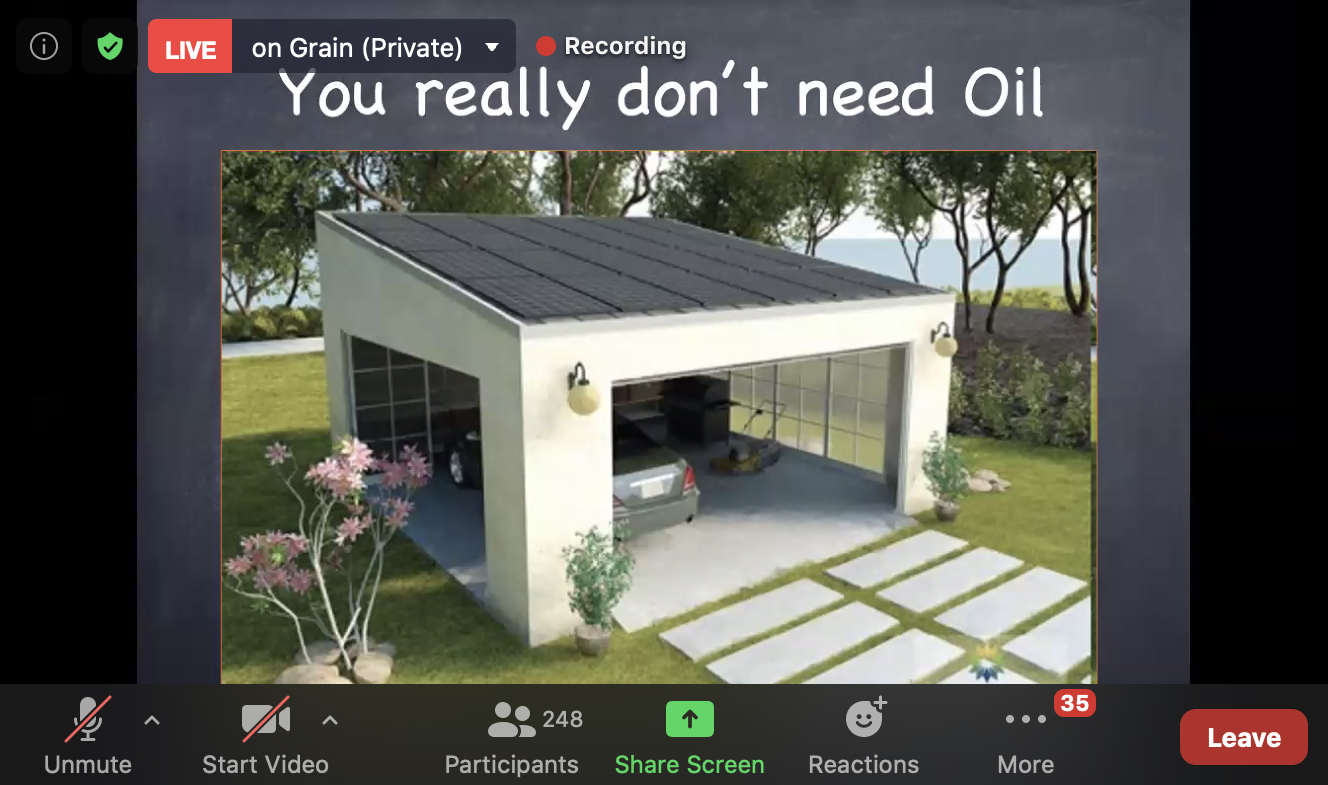
Without permission but with gratitude.
We had the pleasure of attending a conference talk by Marc Tarpenning, founder of Tesla and partner at Spero Ventures, whose conference it was. While telling his story, Tarpenning showed the above slide, which we present here as a gem of simplicity.
Climate change is a confoundingly, crippingly complicated thing to talk about, and its many solutions can be just as convoluted.
Of course climate issues are complicated! It’s all tangled in an inextricable web of complex natural systems — in the soil, it the oceans, in the atmosphere, and (in the case of solutions) in the wildest aspirational bounds of our imaginations.
But this slide demonstrates just how simple and elegant can be both a solution and how we talk about it. As simple as an old windmill gently rotating next to its barn, as elegant as a water-wheel dipping into a river — representing as they do, the provision of exactly the amount of carbon-neutral power that was needed to do the thing inside the buildings to which they were attached.
With solar costs plummeting as they are, why not commit to individually powering every car (and its garage, and its lawnmower) with nothing more than the footprint of the building it resides in? Tarpenning wasn’t making that point exactly, but the slide does, and we should model as many future innovations as we can on such clear thinking and storytelling.
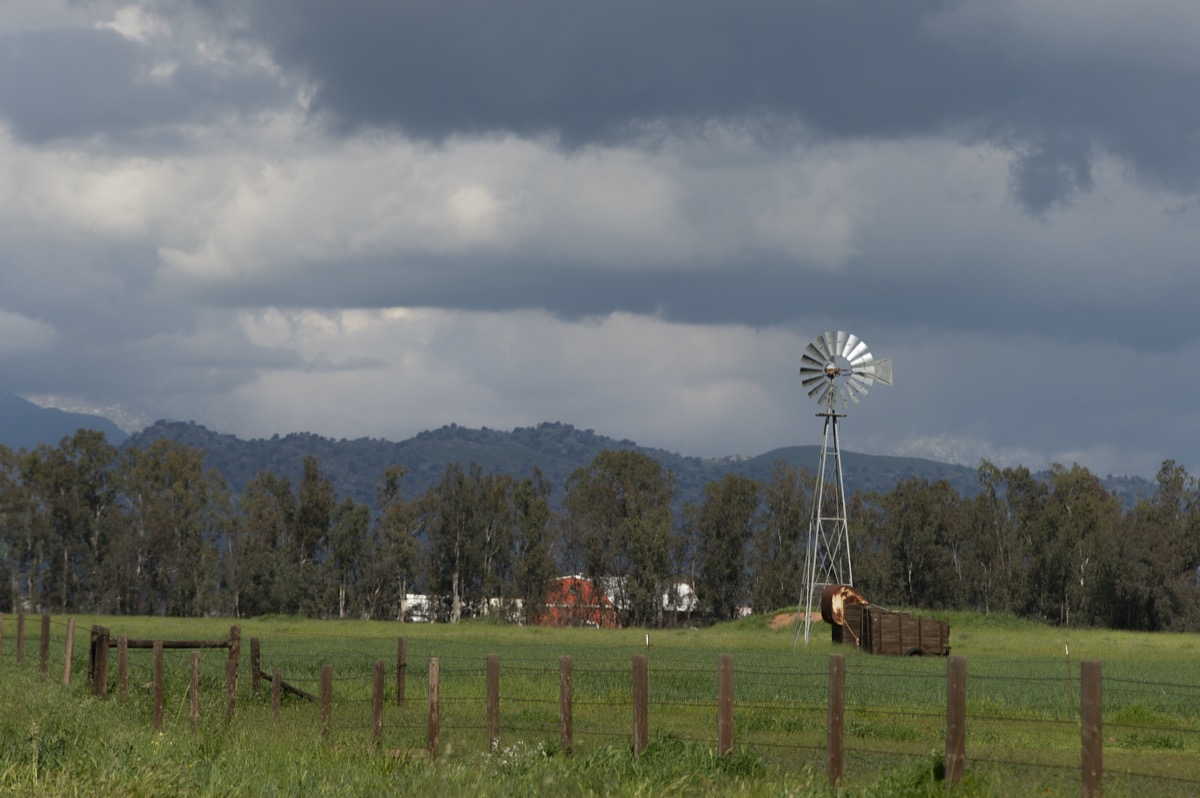
Windmill part of our Drought’s End tour last March.
$
In the meantime, by the way, the solar carport is a not “a thing”… but should be. Go ahead and search for “solar carport” or “solar canopy.” As with all things solar, your buying options are as bewildering and confusing as the above image is not.
Anybody who wanted to make a company to specialize in solar carports — a structure with four posts and a roof covered with solar ideally arranged to catch the sun — with straightforward marketing, installation included, systematically complying with building codes — could make a fortune, and get a lot of human mobility off the grid forever. Please do this now.
Long Live the Covid-19 Climate Silver Lining
When countless millions put their lives and careers on hold to blunt the exponential fury of Covid-19, they also idled their cars, boats, and planes. Likewise trucks, power plants, factories, container ships, trains — all the engines driving global industry and climate change — fell still, and quiet, and idle, if only for a moment.
People took to social media to celebrate the cleaner, fresher air (China! United States! India! Kenya, Uganda, Ethiopia! Planet!), and even anecdotally cleaner water (Venice!), along with fun anecdotes about animals returning to old habitats and even our depopulated cities. Meanwhile in the macroeconomy, oil demand collapsed, economies sputtered helplessly, and conversations began in earnest about what the world should look like in the wake of so much change.
Is it possible to sustain reductions in energy demand? Should we rebuild our old lives as they were? Or, should we try to create something new and different to stave off climate change, mass extinction, and resource depletion?
Since calls for change didn’t prevail, we’ll have to assume the world will revert largely to what it was before: after social distancing, human appetites will return more-or-less to the 2019 version (China!) and we will continue our brisk stroll toward the +2°c climate cliff.
But even though we don’t harbor any illusions of a deliberate correction to prevent further calamity, we do have three reasons to be optimistic that life won’t completely revert to the pre-Covid Way.
1) Solar Is Officially Cheaper Than Dinosaur Fuels
The pandemic has coincided with the demise of coal as a cost-competitive energy source. Over the past few years, one report after another has concluded that sustainable energy sources (on the heels of natural gas) have reached or are about to reach cost parity with coal and oil. As the costs of windmills, solar panels, energy storage, and wave energy plummet, planners are able to factor them into their ledgers without pleading with accountants and budget-obsessed politicians. In fact, it should now be budget-obsessed policymakers who will drive the move to alternative energies: in November 2018, the Carbon Tracker Initiative even determined that it is cheaper per energy unit to build and use new solar plants than to run existing coal plants.
This January, to help lead a painless transition from coal, the Rocky Mountain Institute, the Sierra Club, and the Carbon Tracker Initiative published “How to Retire Early: Making Accelerated Coal Phaseout Feasable and Just,” laying out…
an integrated three-part approach: 1) refinancing to fund the coal transition and save customers money on day one, 2) reinvesting in clean energy, and 3) providing transition financing for workers and communities.
Oh, how we look forward to retirement!
If Covid-19 changes human behavior enough to reduce energy demand even slightly, municipalities and power companies should grab the opportunity to take on this transition in earnest. We can certainly see that happening now with the new $1 billion Gemini solar plant with built-in energy storage outside Las Vegas, a city that is virtually synonymous with electricity use. (Say what you like about Las Vegas, but it already has a proven commitment to emission-free sourcing of its power.)

The solar thermal Ivanpah Solar Power Facility lies in the California Mojave within eyeshot of the western-themed casinos of Primm, Nevada, and generates 400 kilowatts of energy. In our opinion, “The Ivanpah Solar Power Facility Is at Home in the Mojave Desert.” But “home” is complicated.
2) Some Social Distancing Habits Will Stick
Some of us already lived on Zoom before social distancing brought the rest of the world to that unglamorous and sterile meeting venue. Now that everybody else’s laptop cameras and microphones are also trained to meet us there, will they remain so once the virus is gone… or will people return to corporate conference rooms and freeway-convenient meeting centers with their stacks of sandwich boxes and a faithful Keurig slowly and noisily bleeding in the corner?
If this virus has indeed ended the traditional handshake, it’s hard to believe that people will return en masse to their old lives of flying across the country to sign an agreement, driving across town for a lunch meeting, or commuting thousands of collective miles to assemble a complete office staff every day. No doubt working and happy-houring in person has substantial benefits (efficient! collaborative! social! psychological!) but the efficiency of popping up a meeting window to meet with the Tbilisi, Georgia team an hour before a meeting with the Atlanta, Georgia team, cannot be denied.
On a bigger scale, will our new patterns be different enough to impact how many cars we will own, how we will invest in infrastructure, how commercial developments will be zoned and built, how concrete and steel will be distributed, how manufacturing and labor trends will trend?
In 2021, might we might see our species slow down and extract fewer resources from the ground, water, and air, for the first year in its modern history?
3) The Young Will Not Stand Idly By
The generation rising now through the unprecedented, destabilizing shock of a global pandemic has already cast off the “entitled” and “lazy” labels that older generations always love to throw at the young.
Greta Thunberg has stood out among them for the brilliant, brutally honest spotlight she shines on the condition of the world we’ll leave them. Her “How Dare You” speech at the UN Climate Summit last September and “Our House Is On Fire” speech the previous January at the World Economic Forum are devastating condemnations of the global community for our bureaucratic paralysis and collective lack of willpower. They should be required watching by any among us who find themselves flirting with a “go-slow,” passive approach to righting the ship of climate.
But she’s just one of many around the world who are combining a native understanding of modern media with youthful passion and a clear undiluted perspective on the world around them. There was already reason for hope in the willingness of thousands to risk detention for the climate strike; but now, as we are forced by circumstance to recognize the global and lethal nature of the threats we face, it is the young who are not as deeply entrenched in habit, not as likely to try to hang on to the comforts that we need to kiss goodbye in order to move forward. If this year’s protests are any guide, this generation may power us all past life as usual, while there is still time to preserve as much of the usual that we need.
Last month we mentioned young Ugandan activists working in this vanguard; later this summer we’ll assemble more young voices here as we continue to learn how to stop talking and listen to the people who are living the impact of climate change and leading the way out of it.
We All Need This to Be a Genuine Reckoning

It’s time we listen to George Floyd: “I can’t breathe.”
This has been an intense month of national and global reckoning. This time, we want it to stick. We want the world to scream as one that black lives matter, and, in the silence that follows, we want no more black lives ended violently, no more of this persistent brutal streak of global history that our sophisticated human thought organs should have no problem putting behind us once and for all.
To move forward, we need this.
As the protest grows, so too does the reality it confronts. Almost every day there’s another video documenting a public war on black life … while … somewhere else another Confederate flag seems to wave in response … while … George Floyd in his desperate last minutes reminds us that after Eric Garner’s 2014 cries of “I can’t breathe,” we somehow failed to establish a national reckoning on race to end all national reckonings on race … while … we remember beloved Minnesota schoolworker Philando Castile, whose globally webcast 2016 police death still haunts millions who seemed at the time to have been shocked out of our complacency; and yet somehow Castile’s horrific public death wasn’t able even to prevent that of George Floyd at the hands of a police agency just one town over … while … globally witnessed too was the death of Walter Scott as he ran away from a South Carolina police officer in 2015, hardly nine months after the death of Michael Brown provoked unrest in Furguson, Missouri, which birthed Black Lives Matter and which seemed to provoke what could become a lasting national reckoning … while … every new killing only reminds us that the ones before did not create a lasting reckoning, and makes you wonder what is the core defect of the human organism to fail to find such an obvious and simple conclusion — black lives matter — and act on it … while … even in June 2020, directly in the wake of George Floyd’s death, Rayshard Brooks was killed in Georgia, fleeing like Walter Scott did from a police officer who, himself — like all of us — was already living his every minute in the echoes of the national reckoning after George Floyd, and yet could not find the humanity to spare the life of an unarmed man helplessly fleeing … while … Floyd’s own death happened while we were already, or should have been already, in a national reckoning following the death in May of Breonna Taylor, an African-American emergency room technician killed by police in her sleep in her Kentucky apartment, and within days of the brutal murder of a jogger named Ahmaud Arbery, killed in Georgia — the very same U.S. state of Georgia where Rayshard Brooks would die by police weeks later … while … while … while …
If this way of telling feels like a mushroom cloud, it is also a tip of the iceberg. It is also a part of an unbroken, linear, continuous story that began 400 years ago when a ship arrived in Jamestown, Virginia, carrying Angolans to be sold as this country’s first recorded slaves. While some continue living that story, others among us are able to tranquilize ourselves by participating in what seems to a reckoning. But if the civil rights movement followed Jim Crow which followed slavery, and if Brooks follows Floyd follows Garner follows Rodney King all the way back to Georgetown, what kind of reckoning is this really? If we fail to reckon in earnest with the worst in ourselves, then how can we expect to do bring ourselves together to fix the global systems we have damaged, and create a better world for one another in the meantime?
•
This blog of course is about responding to climate change, and we are here to tell you that these issues need to be addressed right now. Questions of justice and equity are only going to be more acute and more impactful in a future characterized by fewer resources and more compromises and calculations that can either be based on rational understanding, or on instincts, greed, fear, and legacies of bias.
•
Listening to Black Voices of Climate Activism
In any case, I have written too much here. This is a time for the likes of me to stop talking, to listen, to learn. So, just as a start, let’s turn this over to activists of color who are pushing climate activism forward with unfathomably more perspective and knowledge, and more standing, than I have.
•
Collette Pichon Battle
This speech may be the best 12 minutes you can spend understanding the human politics of climate change. I won’t summarize — just listen to Collette Pichon Battle.
“We must have the courage to admit we have taken too much… we cannot close our eyes to the fact that the entire world is paying a price for the privilege and comfort of just a few people on the planet. It is time for us to make society-wide changes to a system that incentivizes consumption to the point of global imbalance. Our social, political, and economic systems of extraction must be transformed into systems that regenerate the earth and advance human liberty globally.”
•
Cheryl Holder
We should all memorize this speech, given from the front lines of the health impact of climate change, already inequitably falling mostly on the shoulders of the poor and of people of color. “Climate gentrification” is already in progress, and the healthcare system is already failing those of us with the fewest defenses. Is the United States really ready for dengue fever to move into this country, if we don’t even have systems to care for illnesses that are endemic to our population now?
This is my favorite kind of talk. It gives voice to the problem, but it also contains solutions and the optimism that comes with having solutions. As a medical worker, Holder remembers the AIDS crisis as a medical precedent that shows us that we can work together — “to make the climate transition less brutal for all of us.”
•
Hilda Flavia Nakabuye
Just as natural systems care very little about national borders, our community is global in scale and international in perspective. From the perspective of age, nothing can be more humbling, and more inspiring, than watching young people step up to lead the way toward solving the problems we elders have created for us all.
For some of those, activism is borne of loss and of necessity. Their voices need to be understood in that context and with an urgency that not generally been granted to climate change.
We are a generation of scared people. but very ambitious. Very united. Very persistent, and very good at action.
The loudest bullhorn should belong to the young… and luckily, many, many of them are reaching out for it.
•
I’m no more an authority on climate justice than I am on the history of race in America, but I present all this here in the name of building a response to climate change that is just and equitable — just as, right now, we all have to work together to make this reckoning stick this time.
It’s on all of us to build our own expertise, and build it out of a diversity of perspectives. As a baseline, we must commit ourselves to reading and listening on from here.
Seeing Forests Everywhere You Look, Agroforestry Edition
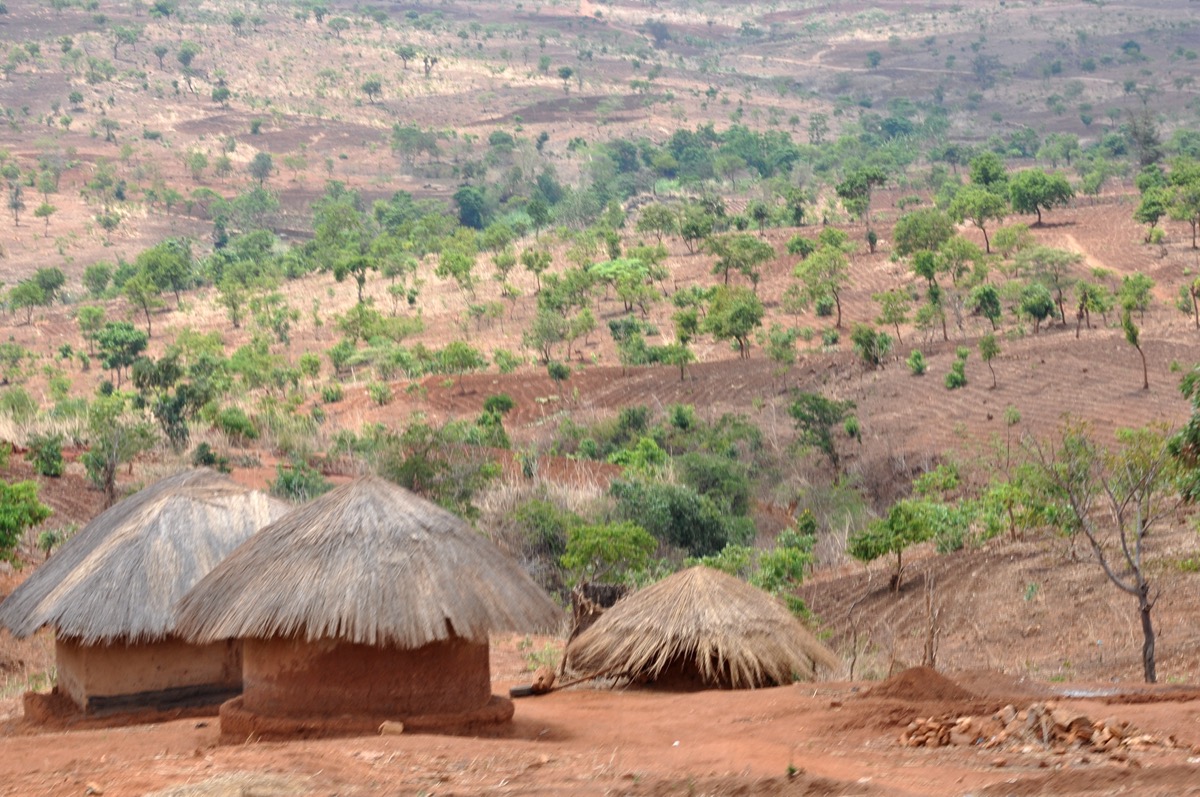
Farm & Forest, Malawi, 2012.
As climate-change solutions go, tree planting triggers all the dopamine.
It’s got it all. You walk out into an abandoned field, lay down some acorns, and step back and watch the system rebuild itself. The toxins are expelled from the ground as a wasteland becomes a forest; the forest attracts animals; the trees absorb the carbon dioxide; and everything cools back down to when we were all younger, more innocent, and free.
It’s impossible not to love that story. Who doesn’t adore the super-feel-good tale of Jadav Payeng, who planted trees for 30 years and single-handedly brought back a forest in India? Or the testosterone-laced idea of drones blasting billions of seedpods like missiles into abandoned land? Or “muvuca,” the quieter, efficient, indigenous-led, drought-resistant method of Amazon reforestation using a mix of 200 kinds of seeds? The slow churning growth of carefully reforested pines on the dead coal mines of Appalachia — and the warm, tranquilizing knowledge that the eastern United States now contains more trees, young as they may be, than it did 100 years ago.
If you do it right, you can look at just about anything and see a forest.
Just Add Surplus Labor…
Meantime, as COVID-19 ravages the world’s economies, it’s created an “epic crisis of demand,” which is on the one hand a tragic employment crisis. On the other hand, it also may be an important, long-overdue, and productive adjustment as we slough off manufacturing and services that may not have been needed or even desired — the artifacts of appetites that endured through the decades like bad habits. Do we need so many TVs and speakers and power strips and swag bags, glitter pens and water-balloon fillers and more bungee cables and 99-cent plastics of every shape and size… and all the labor it takes to make them, market them, sell them, deliver them, consume them, and dispose of them?
We’re not judging, but sometimes it’s good to step back and rethink our habits.
Permanently reduced consumer demand and automation are likely to slash jobs from Shanghai to Melbourne to Reykjavik to Capetown to Chicago to Buenos Aires, and they’re jobs that won’t be coming back. What better use of global surplus labor could there be than restoring unused land to like we found it — in other words, planting trees?
The trouble, of course, is that even if we tried to put things back how they were, the climate won’t necessarily cooperate. More sophisticated — if sometimes less nature-driven — concepts of forestry will be required.
Agroforestry to the Rescue?
One such idea is agroforestry, which, like nearly all tree planting, helps fend off climate change by cultivating and nurturing more CO2-absorbing trees. Agroforestry is the managed coexistence of forest and farm, and as such it benefits the ground as much as it does the sky, nurtures the economy as much as it does the ecology, and provides nutrients and partial shade to people, crops, and livestock. As Daniel Moss wrote in “The Case for Agroforestry” on Devex in 2018,
It’s hard to imagine a simpler, more appropriate technology to combat climate change, improve yields for millions of struggling farmers and make headway on the United Nations Sustainable Development Goals. Farmer-managed natural regeneration is affordable — it requires no external inputs — and preserves local biodiversity that yields traditional foods and medicines. Evidence of this management’s rapid spread — generally locally-led rather than due to foreign funding — has been demonstrated by satellite imagery. The World Agroforestry Centre has found that more than 46 percent of the worlds’ agricultural land has greater than 10 percent tree cover and that this number could be increased dramatically.
Farms vs. Forests
Like “economy vs. ecology” and “mitigatation vs. adaptation,” “farms vs. forests” is one of those binary bugs we should shake out of our blankets once and for all. According to the World Agroforestry Centre (ICRAF), agroforestry
has the potential to improve (i.e. restore) and sustain land health by increasing the diversity of farming systems improving soil carbon (SOC) status and hence soil fertility while providing people with alternative sources of income.
Meanwhile in “the Warm Heart of Africa”…
A case study for the managed integration of forestry and agriculture is Malawi, where agriculture makes up 80% of the economy. Most farming is still done on small family farms which engage approximately 11 million of Malawi’s citizens and help maintain the country’s social traditions even as the population grows rapidly. Farms range from traditional family plots untouched by modern practices to larger enterprises reminiscent of factory farms as mechanization becomes more common.
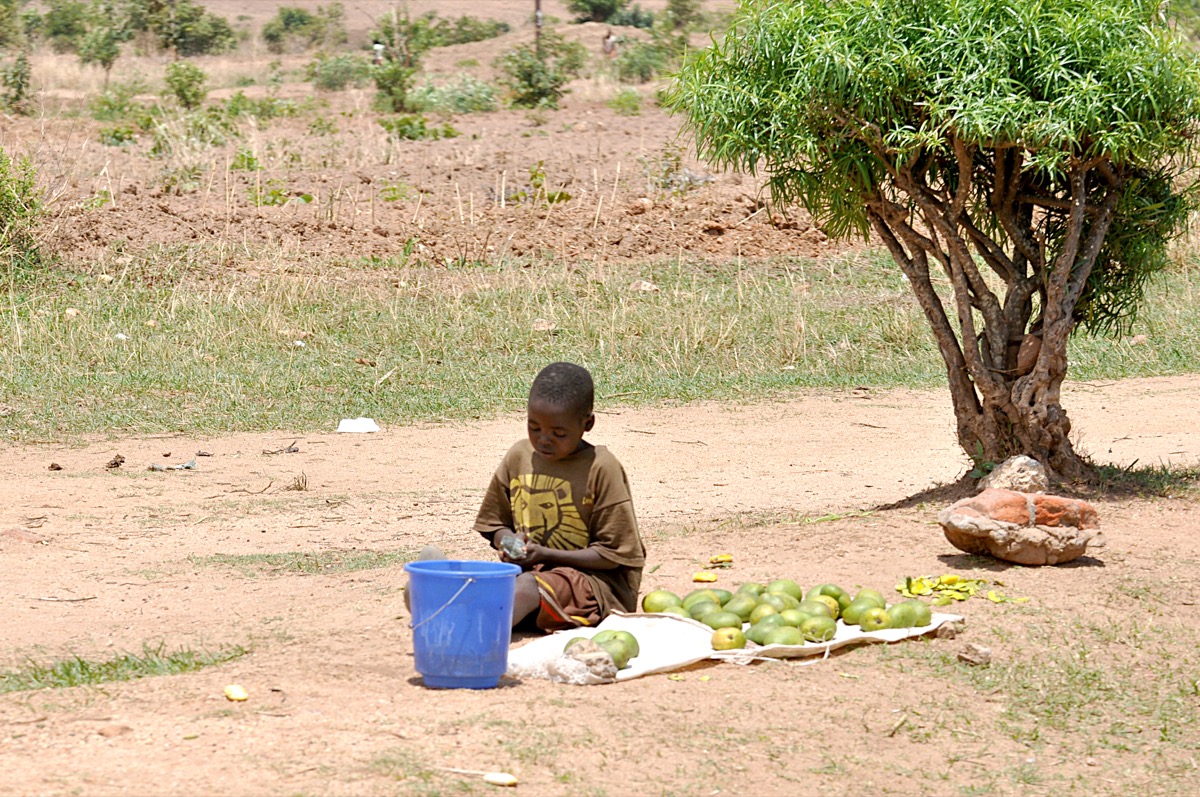
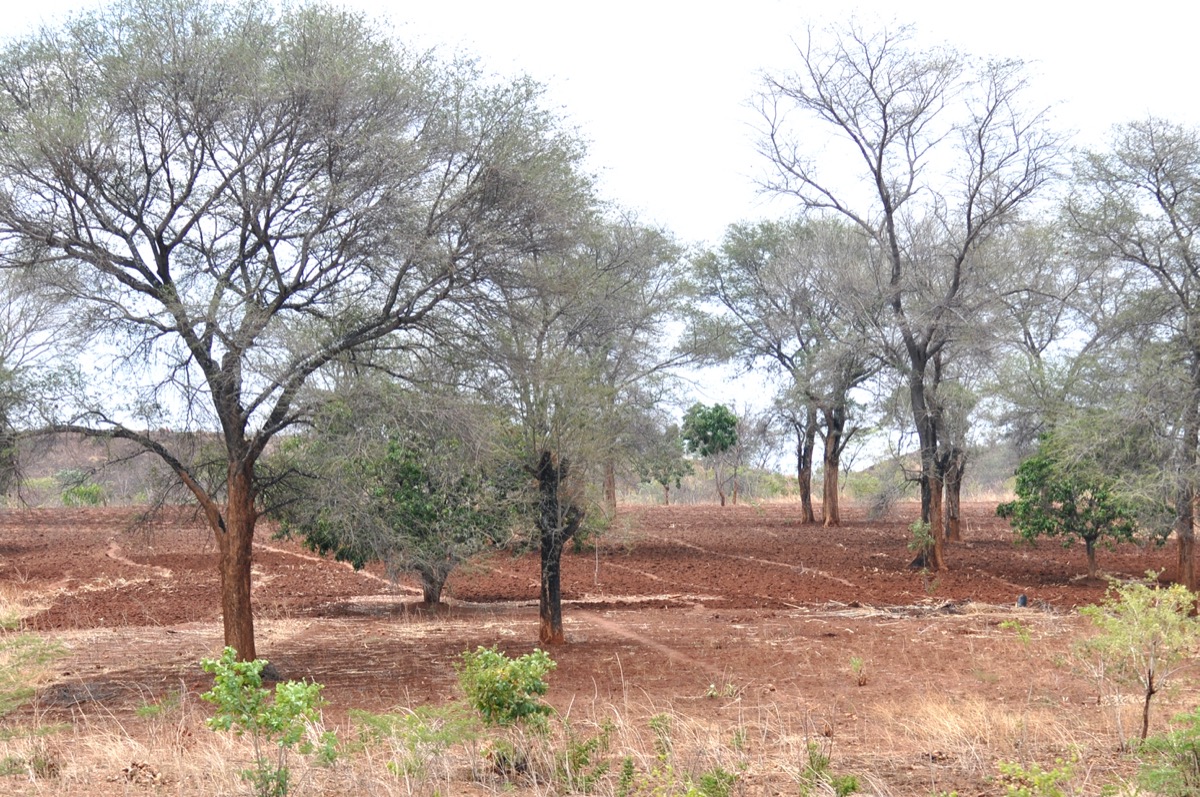

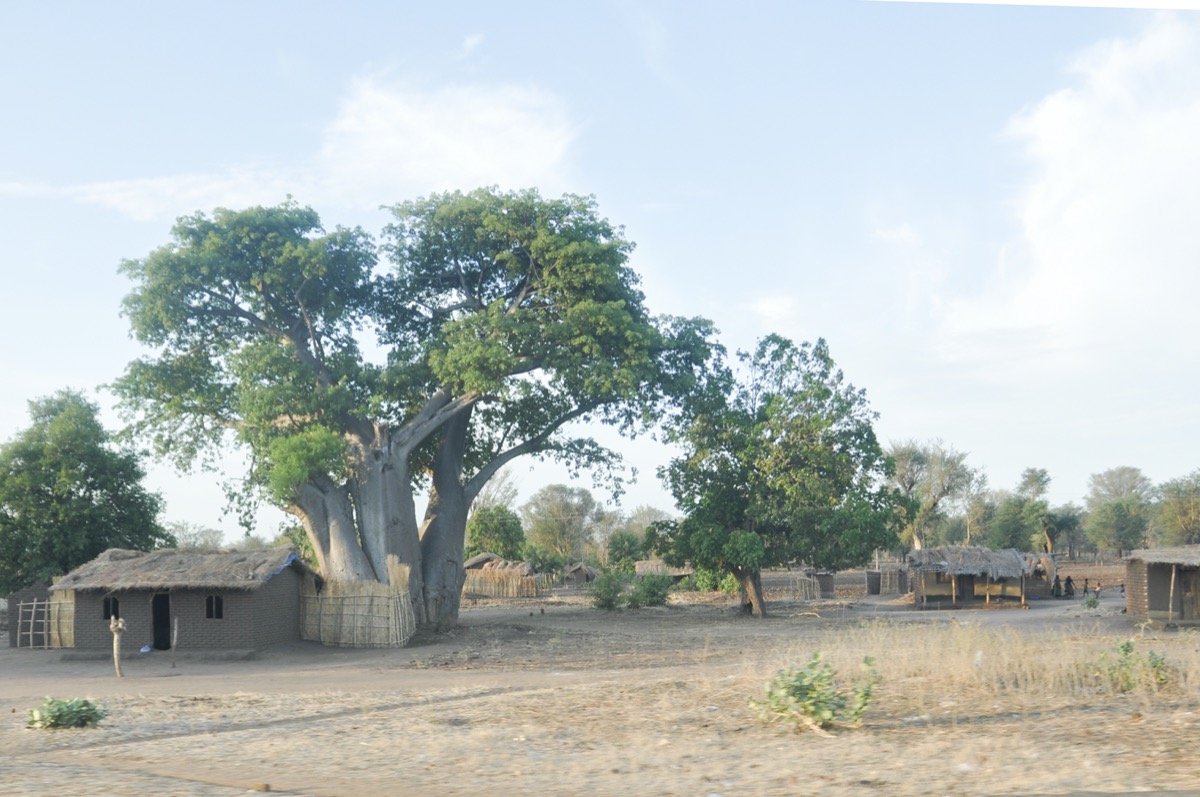
Boy selling mangoes, the fruit of the forest; three farms, Malawi, 2012. All photographs by the author.
The population still lives among agriculture, encouraging diverse uses of farmland and helping to fend off large-scale factory farming. However, rain has been unreliable since the early 1990s and Malawi has been hit hard by drought in recent years, stunting the development of nearly half of the country’s children, and generally creating the kind of rural poverty that has driven urbanization in most parts of the world.
Urbanization is not the only risk of enduring poverty in this long-peaceful country. A development banker told me off the record that his bank would back just about any development program that would put “a hoe, a broom handle, or a baby bottle” in the hands of a young employable person instead of something more dangerous. Noting Malawi’s proximity to the Congo, he meant firearms.
In addition to the drought, imported fertilizers and other practices have badly depleted the country’s arable soil. Inefficient land reduces yields and drives farmers onto grasslands needed by wildlife; and villages are destabilized as farmers travel farther to grow crops and graze livestock.
This is fertile ground for the ICRAF and its partners, who have begun a project funded by the Flanders government to study the impact of more integration of forests and farms.
The main objectives of the project are to 1) assess functional aspects of ecosystem health in Malawi, including to design, deploy and apply a system to establish baselines and monitor trends of land health; 2) obtain accurate statistics on soil organic carbon, pH, texture, soil erosion, root-depth restrictions and woody cover densities, distribution and diversity under agroforestry and assessment of the contribution of agroforestry to land health in the country; and 3) develop tools and interfaces to explore land health indicators, as well as land use, allowing agroforestry to be formally added to national planning.
The idea is cultivate an ideal balance — though not necessarily the original natural balance — of trees on Malawi’s gentle hillsides and, for moving forward in a way that improves soil, increases yield, and reduces chemical use. It isn’t simply about how many trees can be planted in how little time, but how to do so in support of the local population and the global context. Read more about the Agroforestry and Land Health in Malawi Project here.
High Tide for Climate Retreat?
Watching “climate retreat” enter the public lexicon has been a little like watching the sea level rise. It’s gradual and almost theoretical most of the time, and then a king tide comes along to spotlight the new normal.
Sometimes that “king tide” is in the form of an actual king tide (Key West edition), sometimes it’s in the form of a hurricane (see the Bahamas and Puerto Rico?). Today we can thank a head-turning article by Jim Morrison in the Washington Post Magazine: “Climate Change Turns the Tide on Waterfront Living — Rising seas and worsening flooding are forcing many communities to plan their retreat from the coasts.”

We nominate the Post’s Jim Morrison for the Pulitzer for calling coastal retreat “the Voldemort of climate adaptation.”
The article begins in the slowly drowning city of Norfolk, Virginia, whose planning director tours the author around the affluent Larchmont District.
Hurricanes get the headlines, but on this street, it will be the repeated jabs of flooding day after day from climate change, with its rising tides and increasingly stronger storms, that will force the city to make tough choices. By 2040, projections by the Virginia Institute of Marine Science show, the river will overflow its banks and flood this street twice daily during high tides. Norfolk plans to protect the city with $1.8 billion in storm-surge barriers and flood walls, but those projects — if built — won’t stop the rising tides in Larchmont. The water will come. This is where Norfolk will eventually begin its retreat.
One defiant pink house remains, rising two stories on stilts. Another, damaged by a storm more than a decade ago, is a ramshackle, boarded-up shell with “No Trespassing” signs adorning its stilts. The owner won a long and expensive legal battle with the town, which tried to condemn the property. He has refused a $35,000 buyout offer. Instead, he’s waiting for the next big storm to knock the house down so he can collect up to $250,000 in federal flood insurance.
Not a sustainability best practice.
As for Nags Head:
… it has no plans to retreat. In fact, Nags Head removed the idea of retreat from its comprehensive plan years ago. Why? The town can afford to delay the inevitable, preserving a waterfront tax base by spending tens of millions of dollars rebuilding beaches. It’s working. Despite the devastation of three hurricanes in the past four years, property values in Dare County, home to Nags Head, Kill Devil Hills, Kitty Hawk and other destinations, have boomed to nearly $16 billion, 25 percent more than seven years ago.
The beach rebuilding, as we mentioned, is the “nourishment” process of pumping sand from underwater berms back to the beach, and needs to be repeated every few years — with the goal of keeping property values high.
Also not a best practice.
Speaking of best practices, the article contrasts the efforts of Norfolk and neighboring Virginia Beach to buy out and elevate properties with the experience of Valmeyer, Illinois, an entire town that underwent a managed retreat from the Mississippi River after the levees finally failed in 1993.
Managed Retreat seems more sensible, but relocation is prohibitively expensive and complicated. According to the Norfolk planning director, successful relocations…
follow similar models: They start while feet are still wet, they have relocation blueprints in hand or create them quickly, and they have a strong leader. Knobloch [an architect of the Valmeyer success], who has consulted with other towns looking to relocate, says that Valmeyer hit the rare sweet spot of available funding and political will. “If you look at our situation,” he says, “it was probably the only period in recent history where we could have done this, because at both the state and federal level, the people that were involved, both on the political side and on the side of the agencies, embraced this idea, and they had the resources to help make it happen.”
Managed retreat — the collective relocation of entire towns, as opposed to the individual dispersal of homeowners and businesses when wet feet can no longer be ignored — seems like an unlikely best practice as the water continues to rise. But a less-best practice is the likeliest, and probably most human, one — which is just to rebuild where you are.
The first step to managed retreat will be a radical rethinking of federal, state and local policies and subsidies that distort the true risk of living in floodplains. Federal disaster and mitigation funds, for instance, provide little incentive to restrict rebuilding in these areas. That’s fine with cities and counties, because rebuilding in a risky area keeps their tax base intact in the short term. In the long term, though, it’s bad policy, says William Stiles of Wetlands Watch, a Norfolk-based nonprofit organization that works with local governments and other nonprofits on solutions to sea-level rise. “As seas rise, it costs more in public funds to maintain the streets, flood walls, sewer systems and EMT services than the properties generate in taxes,” he says. A study by Zillow and Climate Central last year found that after Hurricane Sandy in 2012, the housing growth rate in New Jersey was nearly three times higher in areas likely to flood once a decade than in safer areas. “Think about that,” Siders says. “More homes, more families at risk. And we’re going to reward that by giving states more money the next time they have a disaster.”
The article is a must-read throughout, and the ideas are here to stay… even after the tide returns to normal or, for instance, we get distracted by a pandemic.
In the Future, Let’s Have Only the Good Epidemics
Bravo Wired for proposing an epidemic, so to speak, that we can all get behind: “Solar Panels Could Be the Best Fad Ever.”
I don’t know about your neighborhood, but in mine I have a hard time finding solar installations to emulate. Still, Clive Thompson reminds us of the potential energy stored up in solar social uptake: “Installing an array on your roof is environmental exhibitionism—and it’s contagious.”
Last I heard, the consensus among architects is to keep the solar as invisible as possible, but Thompson argues for bringing it out front — flying your panels like freak flags if, like most early adopters, you want to inspire your friends and neighbors.
Solar, it turns out, is a virus—a good one. Researchers have been documenting this, and it offers some intriguing hope for climate-change mitigation. Now that we know solar uptake has a social spread, we may be able to make it spread faster.

The “Yin-Yang House,” Venice, CA. All images by the author.
Even as panels get cheaper, home solar arrays are apparently being installed by snails and turtles. But even if the pace is raining on our solar parade, there’s hope for a pandemic yet, because individual actions and government mandates reinforce one another. It’s a snowball effect.
Understanding the viral nature of solar also helps us reconsider the power of individual action. Often, when we argue about how to address the terrifying enormity of climate change, the personal decisions we make seem insignificant. Look, hippie, who cares if you buy LED bulbs or avoid plastic straws? Nothing’s gonna change until the government puts a price on CO2 that forces corporations—our biggest economic actors at scale—to behave more sustainably.
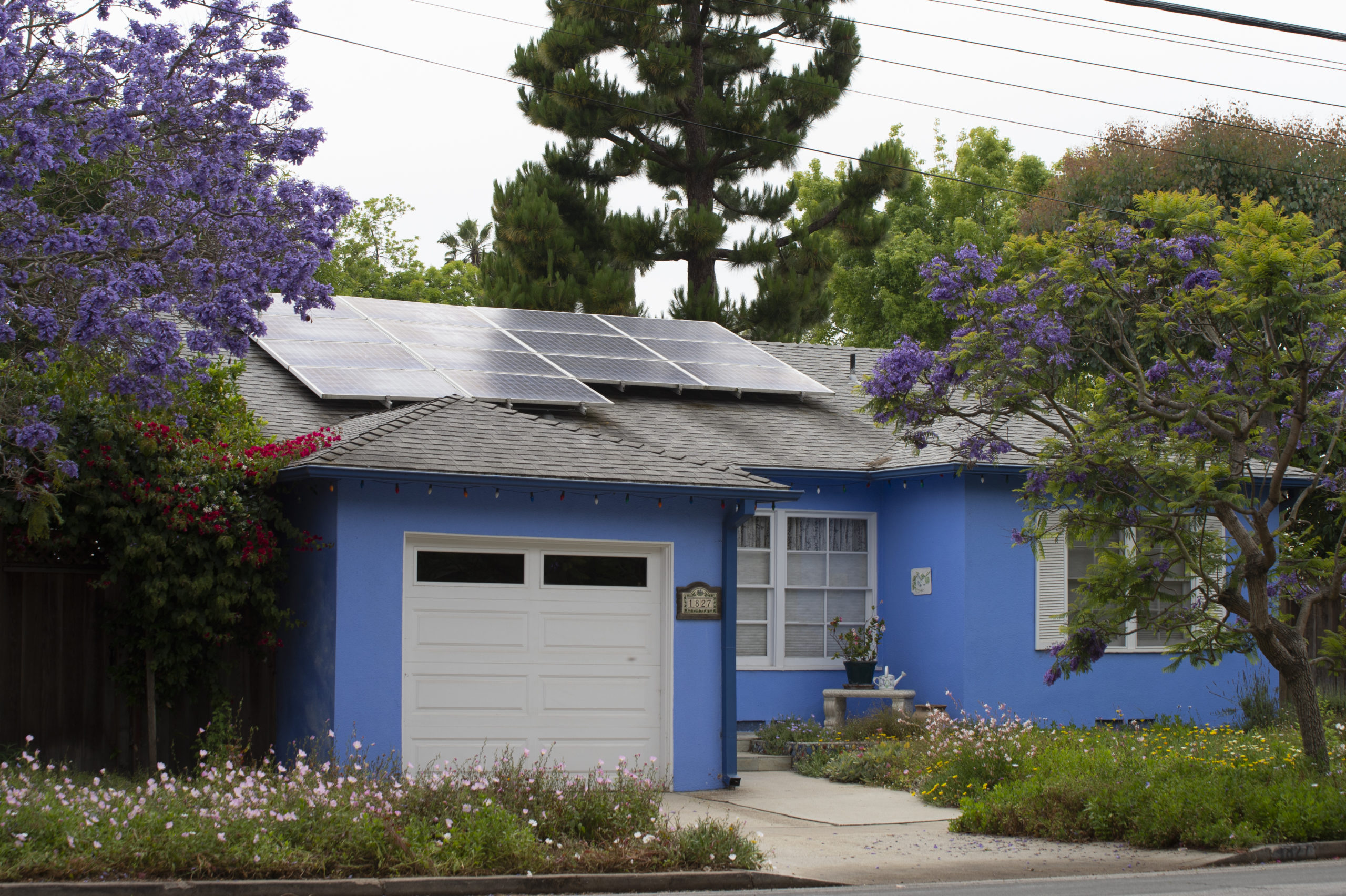
Solar is one of those places where local policy discussions would get really interesting if anyone cared to have them. Carry on with the policy wonkery:
Now, it’s clearly true that mandates are both powerful and crucial. But peer effects have a propulsive energy of their own, argues economist Robert Frank in his latest book, Under the Influence: Putting Peer Pressure to Work. People stopped smoking at a stunning rate not merely because of government mandates, like higher cigarette taxes and bans in restaurants. They also stopped because it became a social cascade. Your partner stopped, so you stopped, so your friend stopped, and then their spouse stopped.
A good government mandate can work hand in glove with our social nature. In other words, your individual actions matter because they are, in a weird way, not merely individual. They spread, outward, like a wave.
Yes, outward, like a wave… like a virus. Let’s take off the masks and spread this one.

Covid-19 Is a Mother of Invention

This year’s wildflower pilgrimage.
I don’t mean to make it sound like the virus has suddenly appeared out of nowhere. We’ve been watching it come, almost in slow motion, our faces glued to coverage of the response in Wuhan, and then across China, and then in Italy. But applying it to our own lives has happened quite overnight.
We always talk about how change-averse we humans are, but look how quickly we are adapting! The most remarkable thing is, no matter how quickly and comprehensively our lives change, our brains go right along with the program! What was normal becomes weird; the weird becomes normal.
I look outside and see two people on the sidewalk, moving toward one another. Would it be bizarre if they hugged hello? Last month, no. Today, contrary to a lifetime of social conditioning, such a thing would be impossible!
Listen to this: today the NBA announced it would suspend its season. A week ago that would not have appeared on a multiple-choice list of things that could conceivably happen. In retrospect it seems wholly logical and that to do otherwise would be strange.
In a week’s time there may be no sports at all. For the first time in our lives. No concerts, no political rallies. The horse race of politics, arguably the biggest game going right now — something that has occupied a huge portion of our collective prefrontal cortex for quite a while — that too could be radically transformed.

Rush hour, La Cienega Boulevard, Los Angeles.
Turns out we humans are very, very good at adapting. We are elastic, flexible, resourceful. We’ll see how well it goes in practice, but one thing we are learning now for sure: we can adapt.
Once we see what is possible — who knows — maybe we can leverage some of the creativity and ingenuity that will come to what we’re going to have to do in the face of, for instance, sea-level rise, or shifts in agriculture due to drought or temperature variation?
Or, is clear and present necessity the only mother of invention?
Five Examples of Climate-Change “Multitasking”
New writing on climate “multitasking” — “5 Strategies that Achieve Climate Mitigation and Adaption Simultaneously,” by Isabella Suarez at the World Resource Institute.
Her five suggestions:
• Protection of coastal wetlands
• Promotion of sustainable agroforestry
• Decentralized energy distribution — and production
• Securing indigenous people’s land rights
• Improving mass transit
The fourth is worthy of highlight, especially since last year’s Amazon fires and the Bolsonoro administration’s counter-productive response (with my emphases added):
Indigenous and local communities manage almost 50% of land on the planet, which up to 2.5 billion people depend on for their livelihoods. These communities have practiced adaptation principles on their lands over generations, developing a deep body of traditional knowledge that can help others understand how to adapt to a changing environment.
What’s more, places where indigenous people have legal rights to their land have at least two times lower deforestation rates than similar areas without secure tenure, as seen in Bolivia, Brazil and Colombia. Indigenous people and local communities have protected forests that hold a quarter of all above-ground carbon in tropical forests. Yet these communities legally own less than one-fifth of this land. Securing indigenous peoples’ rights will ensure they can hold onto their land, protect natural resources and better sustain their livelihoods in the face of climate change.
Readings on the Possibility of Ever Enjoying Anything Anymore

Wetlands are certainly one of those things. (Images by the author.)
Delicate pastel blues and soft buttery yellows illuminated the sky ahead as the lazy winter sun rose. While snow still covered the tops of the surrounding mountains, lower down the colors on them faded from bright whites to browns and greens — hardly a surprise, since temperatures here have been so warm and snow so scarce in this year’s disrupted lead-up to winter. I passed several areas where, in the mid-1990s, I would already have been ice-climbing atop frozen waterfalls at this time of year. Now, they were visibly bone dry with temperatures too warm for ice to form…
I wasn’t so bothered by the legendary Everglades mosquitoes that came out with the spectacular sunset (“You can set your watch to that,” locals say). As they pricked away at exposed skin and whined in my ears, I took it as proof that, for now anyway, the threatened glades biome lives on.
Wired, “Not to Ruin the Super Bowl, but the Sea Is Consuming Miami,” January 31, 2020. The title reveals what we may remember as a characteristic if snarky complaint of our time: can’t we be allowed to enjoy anything anymore? And indeed this article is something of a masterpiece of the moment: a pre-apocalyptic catalogue of all the cataclysms that the water rise have in store for our southernmost metropolis — while insisting all along that there’s no reason not to enjoy the Big Game. Because in 2019, what good would that do… right?
By all means, dear reader, do have a good time!

The reality, in any case, is this:
Part of adapting to climate change no matter how bad it turns out to be will be finding new landscapes and natural systems to love and finding new ways to love new landscapes and natural systems.
Whether it’s primarily an act of heart or one of mind no doubt it will be existentially important to figure out how to do it. For hope and for meaning the children will still need their parents to stand on a mountain or in a rowboat and say, “this here is worthy of your love and protection” — however it compares to what we love and protect now.
How We Tell This Story
Australia has been burning since September, and as 2019 ends forests on all continents lay in ruin. The world is hot — hot, HOT! — and the things we need to absorb carbon dioxide are becoming things that emit carbon dioxide. The illustrations all around us are louder and shinier by the day, but we still can’t figure out how to write about it to translate people’s anguish about koalas and kangaroo habitat into sustained action to reverse the damage we can reverse, and to adapt to what we can’t.
The facts of the story are clear, but the whole thing needs to be rewritten. In this age — where cold expository writing shares a policy microphone with Twitter’s belligerent brevity and Instagram’s hyper-personal informality — where can we find a balance to convey complex, nuanced, and often seemingly contradictory ideas to a public that needs to know or they, their children, and their pets, and their planet, might… die?
The modern focus on “storytelling” offers a clue, and so in international policy and development we punctuate all our communications with still and moving images that highlight what’s happening at the field level — throwing the spotlight on the indefatigable charity hero or on aid recipients with an electric sparkle in their eyes that can directly light the bulb in the reader’s mind.
Converting our work into illustrated tales is extremely effective in a personal, primeval kind of way — the writing cue is to imagine sitting at a campfire while choosing words. But we still have to convey the abstractions too.
Today’s holy grail of abstractions is the UN’s Sustainable Development Goals (SDGs). These are the global community’s agreed-upon interconnected objectives for creating a better world moving forward. In order to strengthen the global network of good work, we’re supposed to build our projects with an eye on meeting some combination of those goals… and we’re also compelled to use them to place our projects in a larger context and show how we “efficiently and cost-effectively leverage” the work being done by others.
Climate mitigation and adaptation projects alike address SDG 13, “Climate Action,” whose name speaks to urgency in the way none of the other SDG names do. Action!! The word explodes with energy, resolve, and unity — an aspirational decision, no doubt, by the framers.
Synergies, Trade-offs, aaaaaaaand… ACTION!
For climate action as well as climate clarity, I love the Nobel-winning International Panel on Climate Change (IPCC). So, for some straight talk, I went over to the IPCC’s FAQ page.
An FAQ, if you think about it, should be a place where expository writing is at its most conversational; after all, it’s a call-and-response attended by people who in being there have admitted they don’t know something but want to. Their guard is down. Talk to them. But bless its heart, IPCC’s FAQ 5.1 reads like this (with my emphasis in boldface):
What are the Connections between Sustainable Development and Limiting Global Warming to 1.5°C above Pre-Industrial Levels?
The Answer:
Summary: Sustainable development seeks to meet the needs of people living today without compromising the needs of future generations, while balancing social, economic and environmental considerations. The 17 UN Sustainable Development Goals (SDGs) include targets for eradicating poverty; ensuring health, energy and food security; reducing inequality; protecting ecosystems; pursuing sustainable cities and economies; and a goal for climate action (SDG 13). Climate change affects the ability to achieve sustainable development goals, and limiting warming to 1.5°C will help meet some sustainable development targets. Pursuing sustainable development will influence emissions, impacts and vulnerabilities.Responses to climate change in the form of adaptation and mitigation will also interact with sustainable development with positive effects, known as synergies, or negative effects, known as trade-offs. Responses to climate change can be planned to maximize synergies and limit trade-offs with sustainable development.
OK. Giving them the benefit of the doubt, summaries are hard to make exciting because they’re like a map that needs to contain every major intersection and attraction — there’s no room for fanciful drawings of sailing ships and dragons. But they do also need to make the reader want to engage. Does this?
The full text is replete with great information. The synergies are wonderful. The trade-offs are lamentable. The reader leaves with no confusion about that — but walks away unchanged.

The author’s failed attempt to urgent-up the IPCC’s answer to qustion 5.1. Could a reader be “changed” by filtering global existentialism through the SDG diagram, where climate change is addressed by SDG 13, and also… 7, 11, 12, 13, 14, and 15, and for that matter the rest of them. This ain’t kitchen-table conversation here.
I present here no new approaches to reach readers in 2020 and beyond; I have no magic words or magic dust or wand to bring the lay reader into the well-meaning abstracted global tangle of SDGs. I don’t recommend screaming in the staccato language of Twitter, or chit-chatting like Instagram. But in my idleness I can see with new clarity the informational minefield of jargon — maybe, the opposite of magic.
Jargon, in 2019, plays a deadly role in the polarizing of public dialogue. Social media and political discourse run thick and bloody with it. And readers recoil from it. As for the field of climate change, after decades of well-funded science denial, you already have to walk through a hellscape of jargon just to introduce the subject— as I just did just now in calling it “climate change” rather than “global warming.”
It’s global warming for crying out loud, and the words “hellscape” and “minefield” apply too. But we tiptoe around them. How much of what we write do we write to avoid saying what we are trying to say, in order to say it?
There has got to be a better way to discuss the world’s problems, a way that’s more universal than the anecdotal stories we can tell (a sinking island, a windmill pioneer) but more effective than the call-to-action climax of the above paragraph:
Responses to climate change can be planned to maximize synergies and limit trade-offs with sustainable development.
How do we shake the readers from their slumber, when it’s existentially important that we do? Will it take the complete loss of an entire city like Miami, or another epic dust bowl across the entire great plains… or can we find a new language that can rise to the challenge of confronting the greatest challenge of human history as it unfolds in slow motion before us?
Rebuild or Retreat: People and Policy in the Outer Banks
The hurricane seasons have been so intense lately that it’s hard to keep abreast of the fallout. Earlier this month, the Washington Post took us to Ocracoke, a North Carolina barrier island in the Outer Banks that’s seriously debating the question of whether to rebuild or retreat.
This debate will come as no surprise to residents of most coasts, on some of which the question of whether to stay home and defend battered homes and traditions among rising shores, risk, and insurance costs has become the stuff of persistent nightmares.
The rest of us, in the meantime, are liable to lapse into a denial that’s even bigger than climate change denial. But that won’t last — especially as the Russian Roulette of hurricane season brings frantic media attention to one beloved coastal landmark after another.
Scientists have long warned that Ocracoke’s days are numbered, that this treasured island is a bellwether for vast stretches of the U.S. coast. “Virtually everyone from Virginia Beach south to the U.S./Mexico border is going to be in the same situation in the next 50 years,” said Michael Orbach, professor emeritus of marine affairs at Duke University. “And it’s only going to get worse after that.”
Interesting Policy Problems, Even More Interesting Human Stories
While some residents and businesses in Ocracoke begin to rebuild, maybe on higher stilts or with better weather sealing, a tale of coastal slower encroachment is told in Nags Head, further north, where some parts of the Outer Banks shoreline are disappearing as quickly as six feet per year. There, the erosion has created a slow-motion policy teeter-totter as the city implements policy for for safety and beach access and “nourishes” the shoreline by pumping sand from the sea floor onto the beaches — an engineering band-aid that costs tens of millions of dollars and lasts as little as two years. (“We’re not supposed to be here,” acknowledged John Ratzenberger, the town commissioner in charge of the project.)
What do you do if you’re a town that’s responsible to maintain public beach access while ensuring safety and services for the residents of East Seagull Drive, whose homes are in the path of an advancing Atlantic Ocean? You buy the houses and demolish them before the sea can do it — or you try.
It seems simple enough, but every single civic, county, or state action to impose a new logical human presence against the powerful advance of nature is going to come into conflict with colorful local characters, traditions, and history, as welk as a property-rights battleground unique to that place. It makes for a good read.
Even if the national spotlight doesn’t endure long after a hurricane or other major weather event, these stories are accumulating into a new literature in coastal America — and everywhere else where there’s a coast. It’ll make for good stories, but it also needs to build into logical practices and policies for climate retreat as the seas continue to rise.
UK Windfarms Stir Up the Energy Mix
Milestone! “Renewable Electricty Overtakes Fossil Fuels in UK for First Time,” reads a Guardian headline.
In the first quarter of this year, thanks to new offshore windfarms, renewable sources outproduced fossil fuels in the UK’s electricity mix.
It’s bright, shiny news, and a kick in the teeth to the old economy vs. ecology saw. (And when I say “old,” it’s not that old. Only two years ago conference speakers could still commonly be heard laughing that renewables were forever doomed to be novelty meat in the energy kitchen.)
Kwasi Kwarteng, the minister for energy and clean growth, said the renewables record is “yet another milestone on our path towards ending our contribution to climate change altogether by 2050”. He said: “Already, we’ve cut emissions by 40% while growing the economy by two thirds since 1990. Now, with more offshore wind projects on the way at record low prices we plan to go even further and faster in the years to come.”
This is only possible due to the cost of wind and solar plunging beneath that of oil and coal, but let’s face it — it’s a headline on its way from novelty to commonplace, and that’s good news for everybody but the chimbly sweeps.
Let’s Hush Up and Let Them Lead
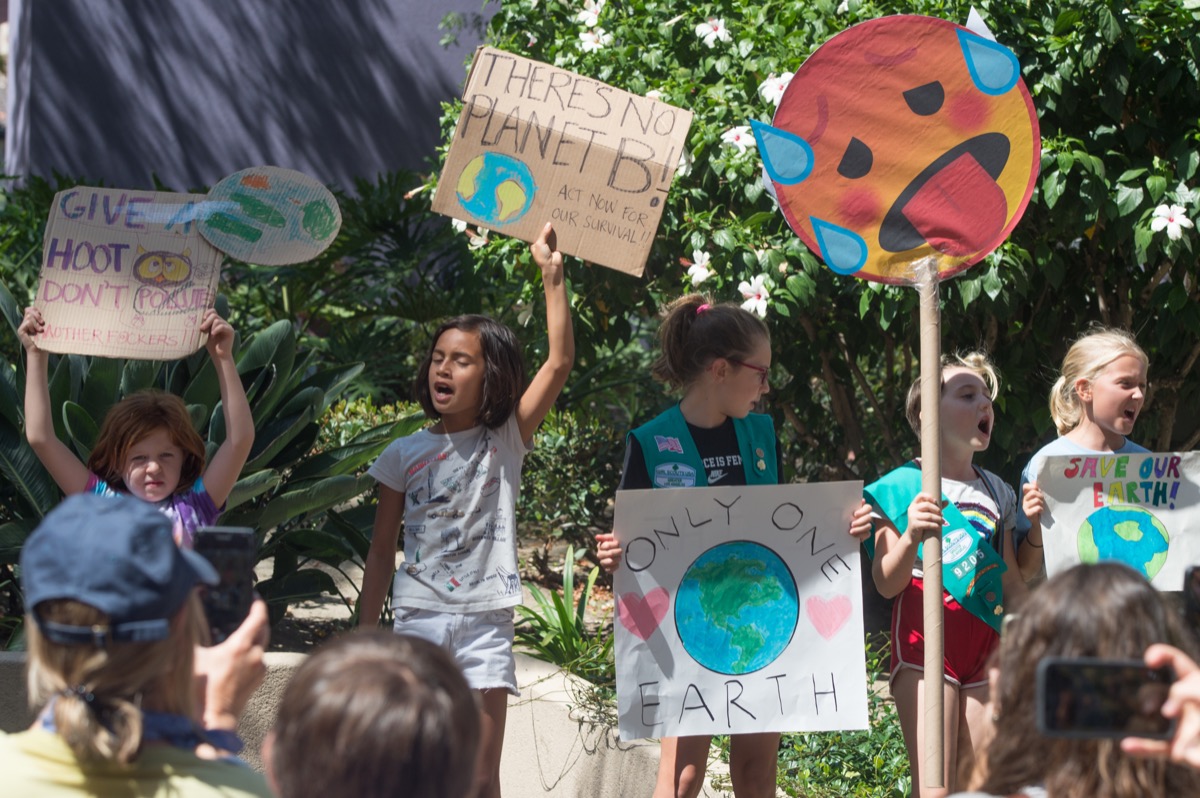
A lot of us spend a lot of time wrestling with the very magnitude of climate change, and pontificating about what to do about it as individuals, as groups… as a species at the crossroads of saving this little planet and destroying it.
Thankfully, the young seem to have figured it out already. The’ve got it. Let’s hush up and let them talk, and then let them lead.

Global Climate Strike, downtown Los Angeles. An estimated four million people hit the streets, led by the young. This is how it’s done.



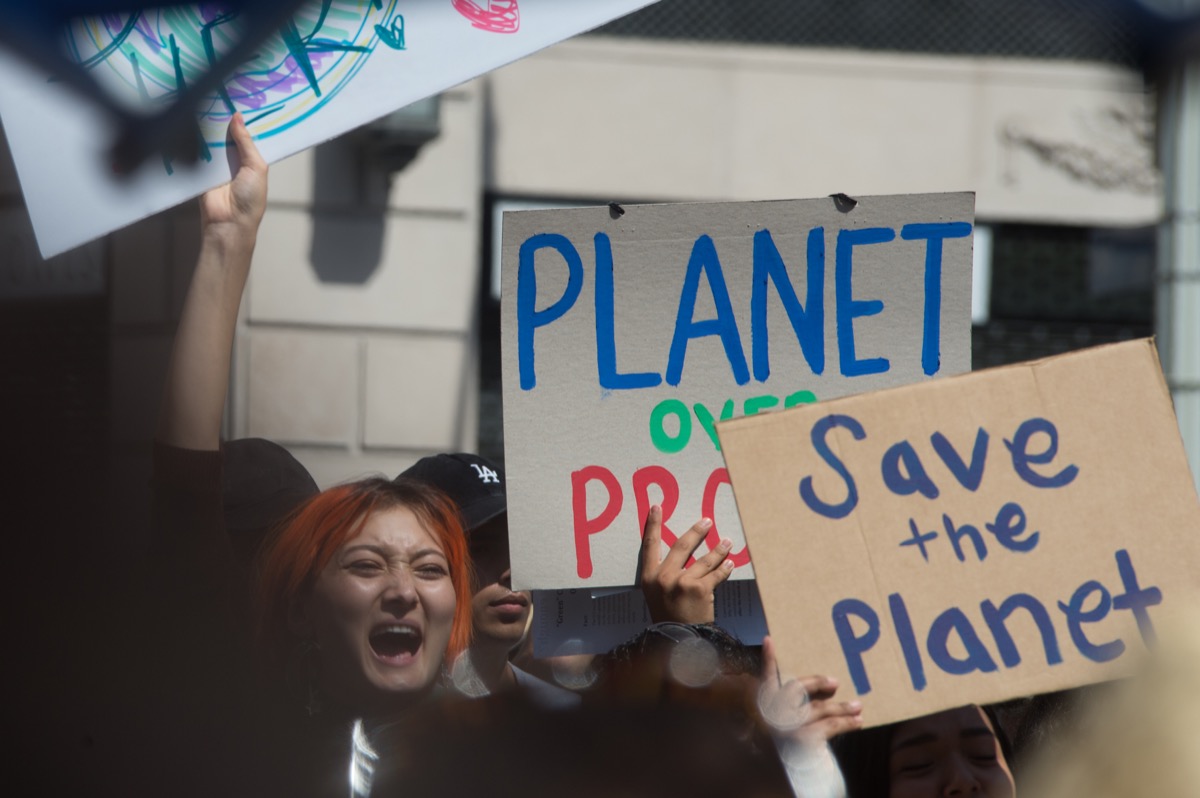
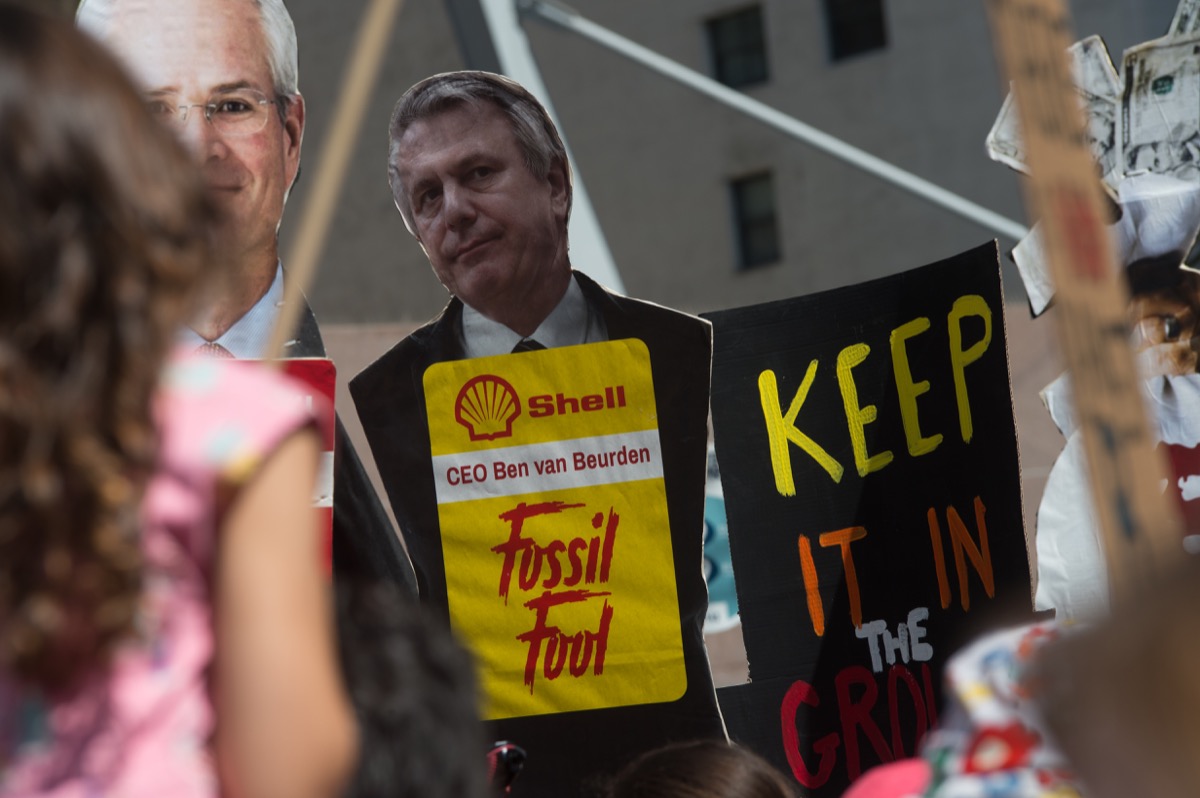


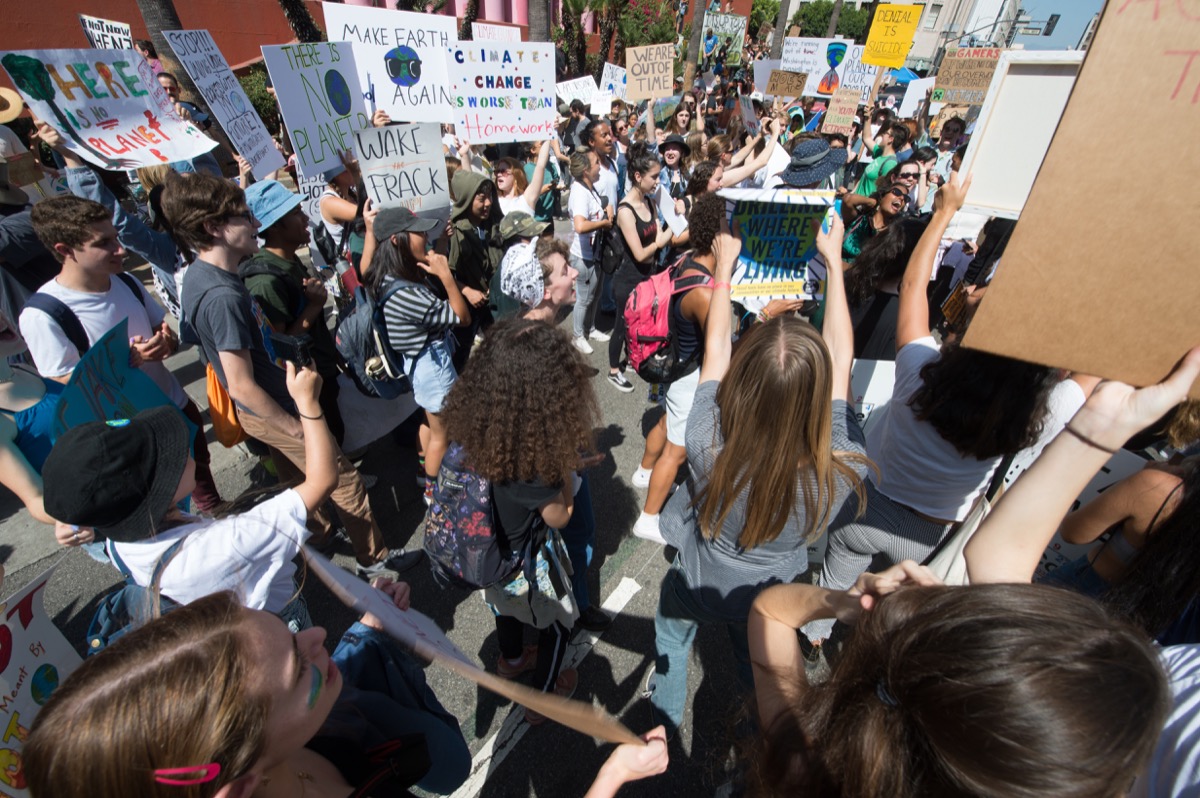
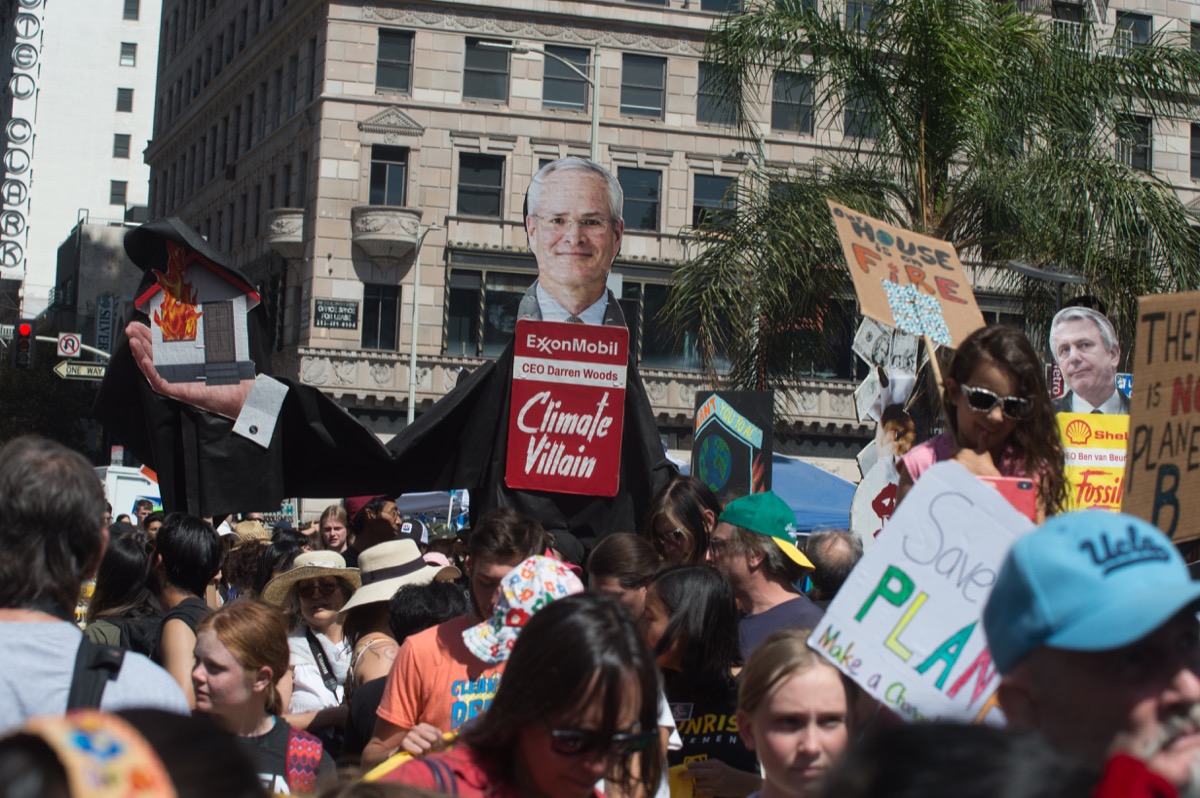
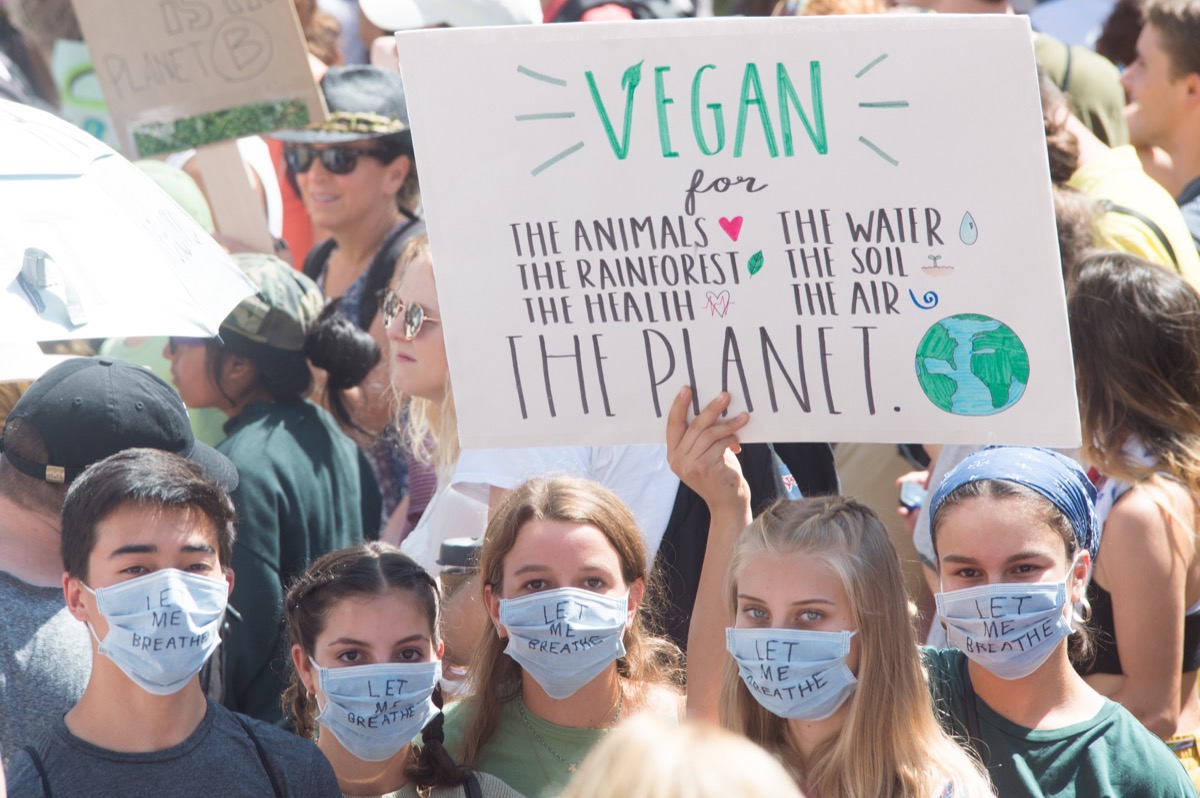

The L.A. Times Drops an S-Bomb
Yesterday the L.A. Times’ editorial board used the “s-word” and it was sweet and satisfying. Smart and serious. “Surviving climate change means an end to burning fossil fuels. Prepare yourself for sacrifices.”
Imagine that — “sacrifices”! — And in the title even.
“What is required, at a minimum, is a radical change, as quickly as possible, in the way the world produces and consumes energy. The goal is to eliminate most future emissions, especially of carbon, and to “capture” the carbon that is emitted so that it does not enter the atmosphere.”
Completing its no-BS three-part series on the urgent affair of the environment, the Times lays down the gauntlet. Society will have to adapt by “crafting approaches to handle the flow of migrants as regions of the world become uninhabitable, protecting people in low-lying lands from rising oceans, and preparing for the excessive heat, longer droughts, more ferocious hurricanes and other extreme weather events that will, among other things, threaten the global food supply.“
The thinking is so clear that it starts to describe a world that is not just cleaner and more efficient, but better than life with internal combustion, with a higher quality of life.
What will our world look like in 15 years if we begin to do what we have to do? Charging stations for motor vehicles as plentiful as gas stations are now. A significant drop in gas-powered vehicles through phased-out production, and government-funded buyback programs to get older cars off the road. Millions of people working to create new power systems; the world needs cheaper and more efficient solar panels, bigger and more efficient energy storage systems, more utility-scale renewable production facilities and more efficient hydro and geothermal technologies. Oil companies will no longer have such disproportionate influence on government policy. Perhaps they will have become energy companies, transitioning away from fossil fuels — or perhaps they will have been superseded by new energy providers.
But it keeps it honest:
Sacrifice will be a part of this too. Doing the right thing will require shifts in employment, changes in consumer habits (cutting way back on meat consumption, for instance, reduces global carbon emissions). We will drive less, ride more public transit, use less air conditioning. Costs will undoubtedly rise for goods we’ve taken for granted.
We’re grateful for both the medicine and the spoon full of sugar.























